Northeast India is a biodiversity hotspot for birds and is home to a variety of species. From the rare and endangered to the more common species, the region is home to an incredible variety of avian life.
The region is also an important stopover for a variety of migratory birds, making it a paradise for bird watchers and conservationists alike.
With its diverse landscape, the region is home to a variety of habitats, each of which supports a unique bird species.
From the lush green hills of the Himalayas to the evergreen forests of the Eastern Ghats, the region is a haven for birds and a must-visit destination for bird watchers.
1. Blyth’s Kingfisher

Blyth’s kingfisher is a species of kingfisher found in the genus Alcedo and is the largest species of this type of bird. It is named after Edward Blyth, a British naturalist and ornithologist.
This species has also been known by another scientific name, Alcedo grandis, as well as by the common name of great blue kingfisher. This species is found in areas ranging from India to the Philippines, and it has a bright blue and orange plumage.
Its diet includes small fish, insects, and other invertebrates, which it catches by hovering over the water and then plunging in to catch its prey. Blyth’s kingfisher is a solitary bird and does not form any kind of social group.
As it is the largest species of kingfisher in its genus, it is quite easy to spot in its habitat.
| Kingdom | Animalia |
| Phylum | Chordata |
| Class | Aves |
| Order | Coraciiformes |
| Family | Alcedinidae |
| Genus | Alcedo |
| Species | A. hercules |
2. Blyth’s Tragopan
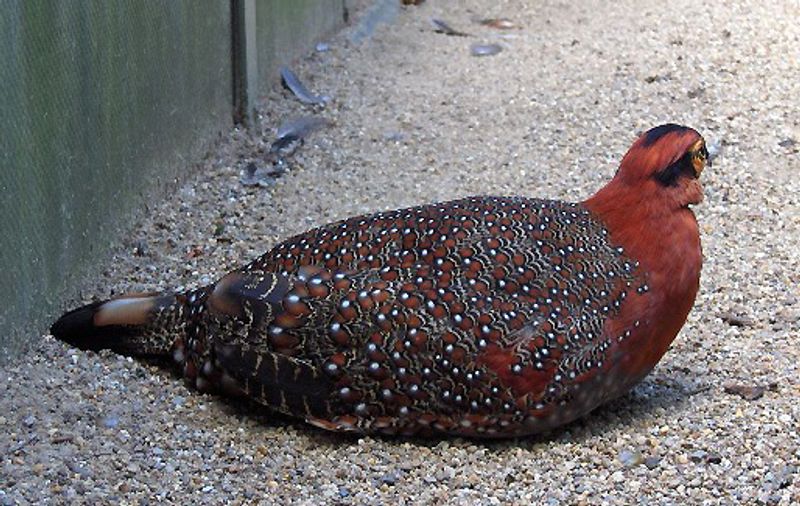
Edward Blyth is an English zoologist and Curator of the Museum of the Asiatic Society of Bengal who is commemorated through the common name of Blyth’s tragopan, or the grey-bellied tragopan. This species is a vulnerable pheasant that is native to parts of Asia.
It has a striking plumage, with a bright yellowish-orange head, a grey belly with black and white checkered markings, and a black and white barred pattern on its wings and tail.
The species is a ground-dwelling bird and prefers to live in thickets, with dense vegetation providing cover. It generally feeds on berries, buds, and seeds, although it may also take insects and other small invertebrates.
Blyth’s tragopan is in danger of extinction due to habitat loss and degradation, as well as hunting and trapping. The species has been listed as vulnerable on the IUCN Red List since 2000.
Conservation efforts, such as habitat protection, have been undertaken to help preserve this beautiful species and to ensure that future generations will be able to enjoy the sight of these stunning birds.
| Kingdom | Animalia |
| Phylum | Chordata |
| Class | Aves |
| Order | Galliformes |
| Family | Phasianidae |
| Genus | Tragopan |
| Species | T. blythii |
3. Bugun Liocichla
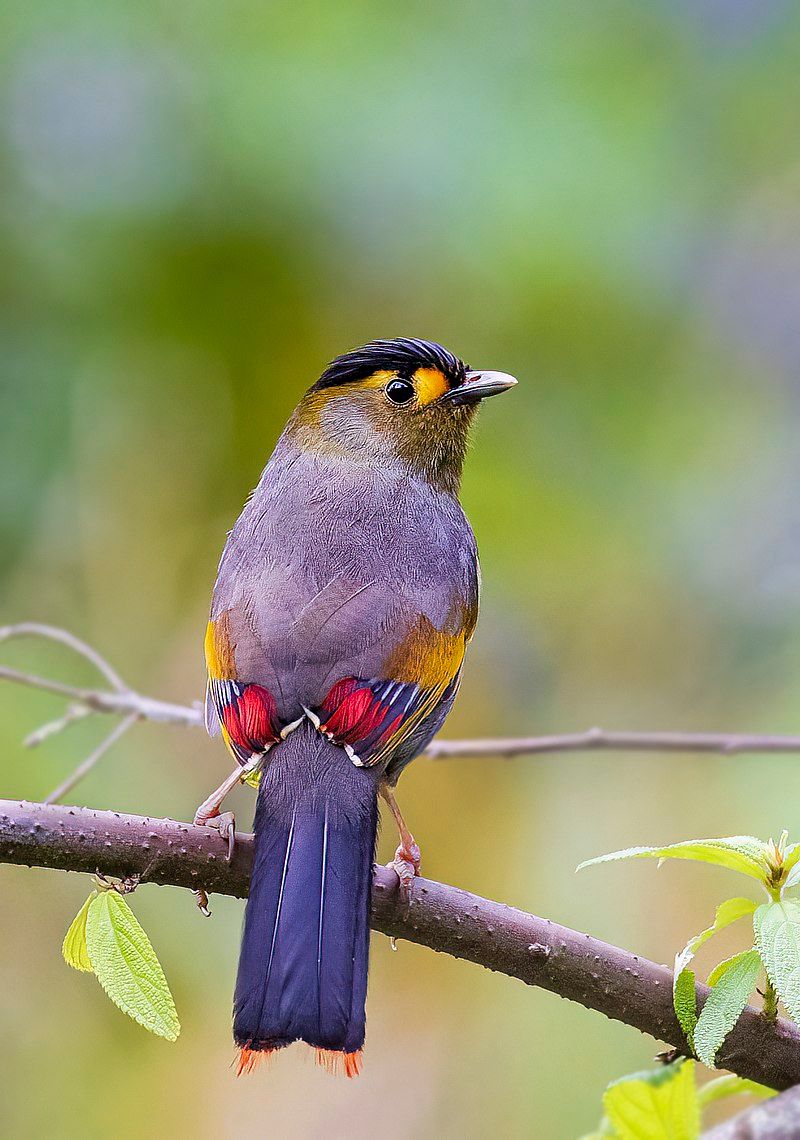
The Bugun liocichla is a species of passerine bird from the Leiothrichidae family. It is closely related to the Emei Shan liocichla, another species from the same family.
The species was first seen in 1995 in Arunachal Pradesh, India when it was spotted by a group of researchers. After further investigations and research, the species was formally described as a new species in 2006.
The Bugun liocichla is distinct from the Emei Shan liocichla in its plumage, habitat, and behavior. Its habitat is mainly located in the high-altitude forests of Arunachal Pradesh, and it is known to feed on fruits, insects, and nectar.
It is a vulnerable species and is protected by the Indian Wildlife Protection Act of 1972. Conservation efforts have been made to ensure the survival of this species, such as the establishment of a protected area for the Bugun liocichla.
The species is also monitored regularly to ensure its population is stable.
| Kingdom | Animalia |
| Phylum | Chordata |
| Class | Aves |
| Order | Passeriformes |
| Family | Leiothrichidae |
| Genus | Liocichla |
| Species | L. bugunorum |
4. Blue-throated Barbet
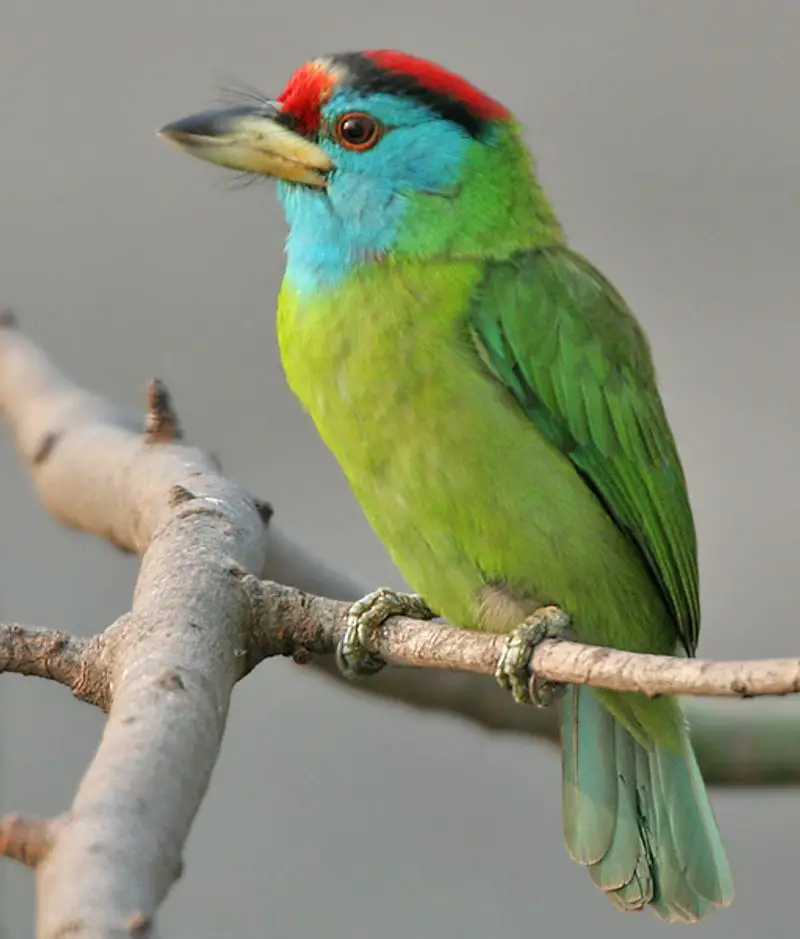
The blue-throated barbet is a species of bird found across the Himalayas and Southeast Asia. It is easily recognizable for its bright green, blue, and red plumage.
This species of barbet prefers to inhabit lowland and montane forests at elevations of 200-2,000 meters above sea level. The blue-throated barbet is a medium-sized bird that is generally found alone or in pairs.
Its diet consists of fruits, berries, and insects. The blue-throated barbet is usually active during the day and can often be seen perched on branches in the trees. It has a characteristic ‘chuck-chuck-chuck’ call that can often be heard in its native habitat.
The blue-throated barbet is an important species for the local ecosystem as it helps to disperse seeds and pollinate plants.
This species is currently listed as Least Concern by the IUCN, however, its population is in decline due to deforestation and other human activities.
| Kingdom | Animalia |
| Phylum | Chordata |
| Class | Aves |
| Order | Piciformes |
| Family | Megalaimidae |
| Genus | Psilopogon |
| Species | P. asiaticus |
5. Beautiful Nuthatch
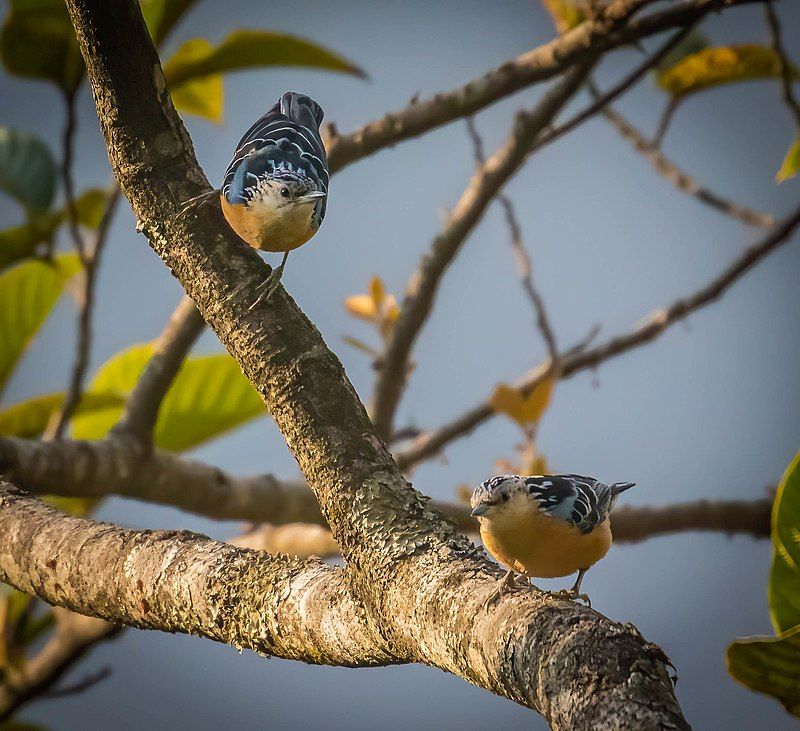
The nuthatch is a delightful bird species that belongs to the family Sittidae, which is commonly referred to as nuthatches.
It is a larger bird than most other species in this family, reaching a length of 16.5 cm, and there is no difference in size or color between the sexes, making it a species that is not sexually dimorphic.
The nuthatch has a long, pointed beak that is adapted to prying insects out of cracks and crevices in tree bark. Its feathers are mostly gray and white, with some black and brown mixed in. Its head is black with a white stripe running from its bill to the back of its neck.
The nuthatch is a very agile bird that is capable of climbing down trees headfirst. It is an omnivore, feeding on both insects and seeds.
Its diet consists of a variety of insects, including ants, caterpillars, and beetles, as well as small fruits and nuts like acorns, beechnuts, and hickory nuts.
It is a common sight throughout North America and is found in a variety of habitats, including deciduous and coniferous forests, woodlands, and urban parks. The nuthatch is a unique and fascinating species of bird and is a delight to see in its natural habitat.
Its distinctive call and its acrobatic behavior make it a favorite among bird watchers. It is also a beneficial species, helping to control insect populations and spreading the seeds of trees and other plants.
| Kingdom | Animalia |
| Phylum | Chordata |
| Class | Aves |
| Order | Passeriformes |
| Family | Sittidae |
| Genus | Sitta |
| Species | S. formosa |
6. Black-throated Bushtit
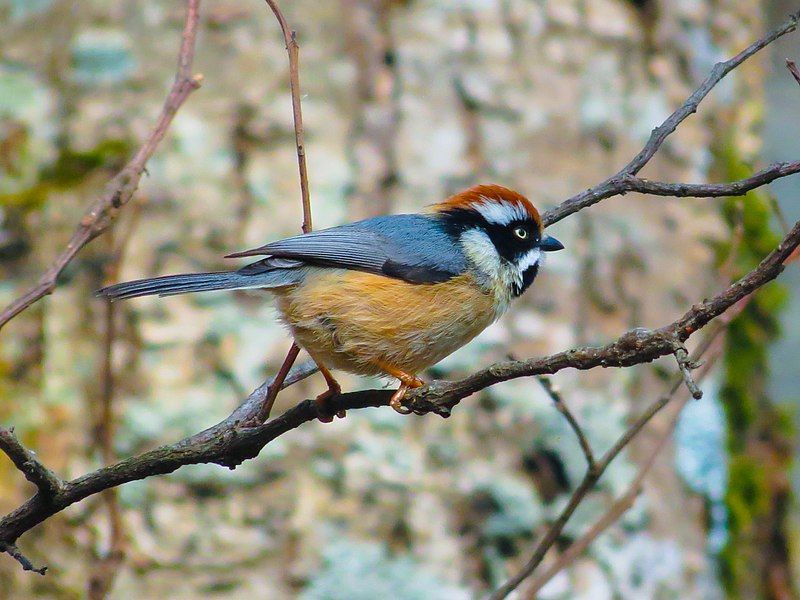
The black-throated bushtit, also known as the black-throated tit, is a very small passerine bird in the family Aegithalidae. This species of bird is native to the dry, open habitats of the western Himalayas, as well as parts of Central and South Asia.
They are typically found in areas with shrubs and trees, such as woodlands, forests, and scrubland. The black-throated bushtit is a small bird, measuring only around four to five inches in length.
The upper parts of their body are grayish-brown in color, while the underparts are white. They have a black head, throat, and breast, as well as a white eyebrow stripe.
The wings and tail are also grayish-brown. These birds are active, social creatures that form large flocks of up to 200 individuals. They feed on insects, spiders, and other small prey.
They often search for food in trees and shrubs, picking food items off the leaves and branches. The black-throated bushtit is a very vocal species. They make a variety of chirps, clicks, and buzzes.
Their calls are often used to communicate with one another during social interactions. The black-throated bushtit is a common species, with an estimated global population of around 8 million individuals.
Despite this, they are currently listed as a species of “Least Concern” on the IUCN Red List.
| Kingdom | Animalia |
| Phylum | Chordata |
| Class | Aves |
| Order | Passeriformes |
| Family | Aegithalidae |
| Genus | Aegithalos |
| Species | A. concinnus |
7. Beautiful Sibia
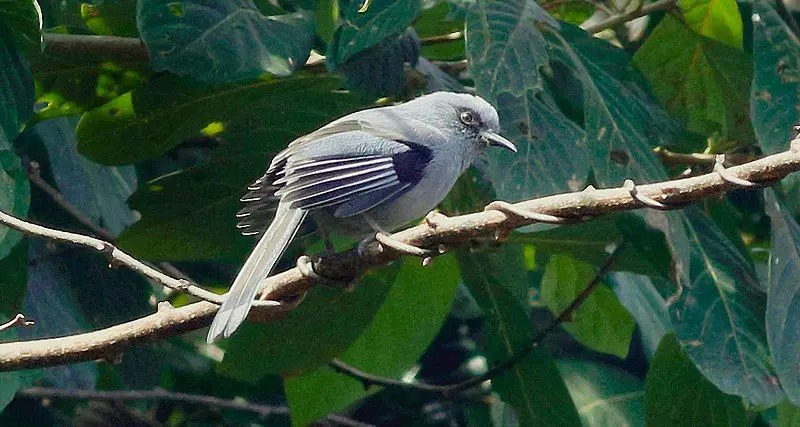
The sibia is a species of bird native to Asia. It belongs to the family Leiothrichidae, which is a group of passerine birds that includes laughingthrushes and babblers.
The sibia is found in China, India, and Myanmar, and is most commonly spotted in subtropical and tropical moist montane forests. These forests are typically located in mountain areas and are characterized by an abundance of moisture and humidity.
The sibia is known for its bright and colorful plumage, which consists of shades of grey, green, and black. The sibia is an omnivore, meaning that it eats both plants and animals. Its diet consists mostly of fruits, flowers, and small insects and arthropods.
It is a social bird and is often seen in flocks of up to ten birds. The sibia’s call is often described as a loud, ringing trill.
| Kingdom | Animalia |
| Phylum | Chordata |
| Class | Aves |
| Order | Passeriformes |
| Family | Leiothrichidae |
| Genus | Heterophasia |
| Species | H. pulchella |
8. Black-headed Shrike-babbler
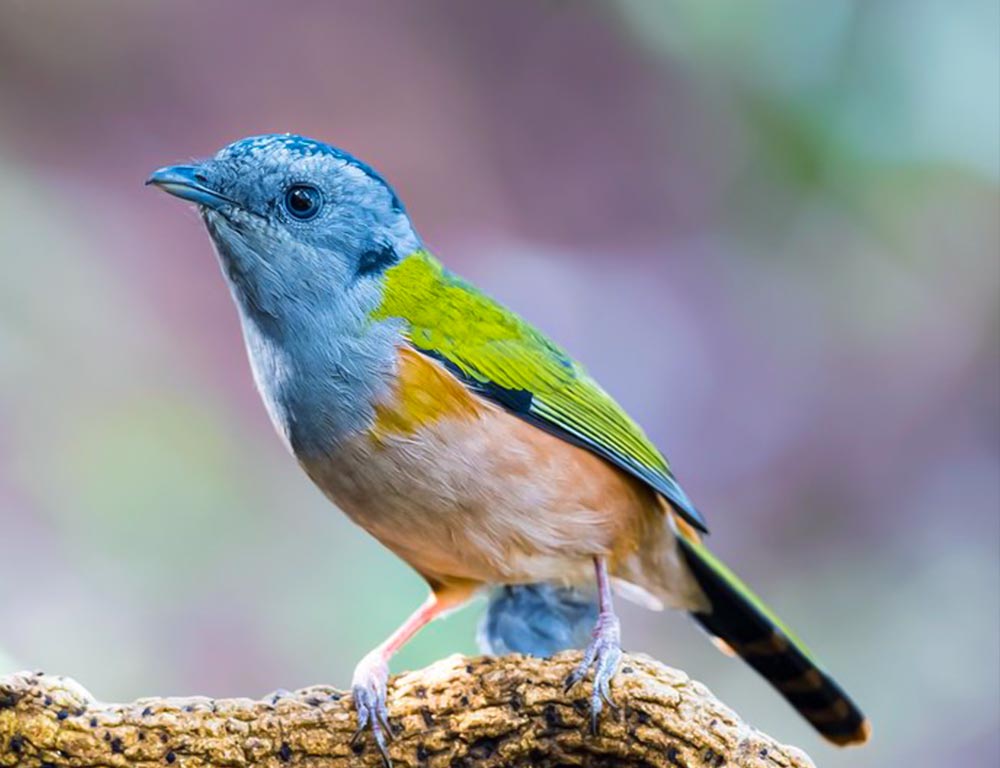
The black-headed shrike-babbler is a species of bird found in parts of Eastern Nepal and Northwestern Vietnam. It is part of the family Timaliidae, which are commonly known as Old World babblers.
There is some debate, however, as to whether or not the black-headed shrike-babbler is one of the few Eurasian vireos. It is quite distinct from other Old World babblers, as it is found in an area much more limited than many of its other family members.
This species is unique in that it is found in a smaller geographical area than other Old World babblers, and its status as a Eurasian vireo is still under debate.
| Kingdom | Animalia |
| Phylum | Chordata |
| Class | Aves |
| Order | Passeriformes |
| Family | Vireonidae |
| Genus | Pteruthius |
| Species | P. rufiventer |
9. Blue Whistling Thrush
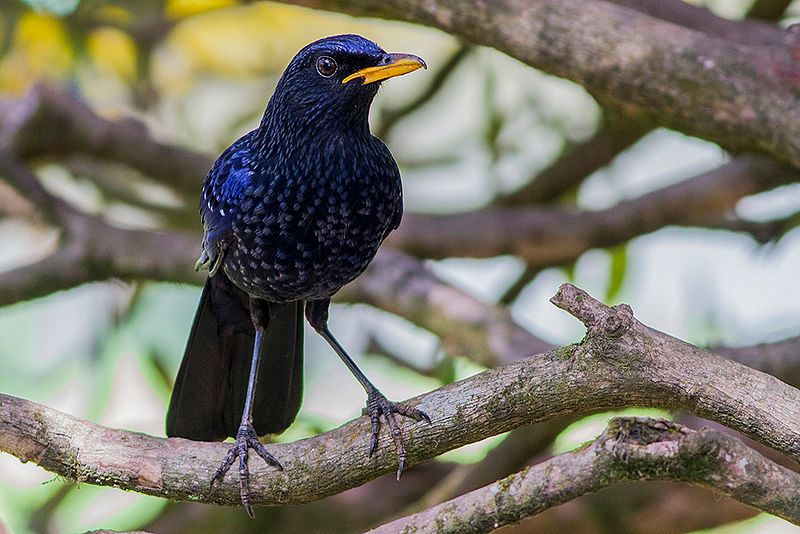
The blue whistling thrush is a species of bird that belongs to the family Muscicapidae, also known as Old World flycatchers. This species of bird is native to many countries in Central, South, and Southeast Asia, including China.
It is most commonly found in the mountainous regions of these countries. This species of bird is especially notable for its loud and distinctive sound, which resembles that of a human whistling.
This sound is usually heard at dawn and dusk, making it a common auditory feature of the mountain regions where it is located. The blue whistling thrush is a medium-sized bird, with a dark blue, grey, or black plumage; and a white or cream-colored belly.
It also has a yellow bill and yellow legs. It prefers to inhabit open woodlands or forest edges and is often seen perched on bushes or low trees. The diet of the blue whistling thrush consists mainly of insects, berries, and other fruits.
It also has a habit of taking food from people, particularly those who visit its mountain habitats. In addition to its loud whistling song, the blue whistling thrush is also known for its habit of imitating the sounds of other birds.
This behavior is often seen as a form of communication between the birds, or as a way of defending its territory. Overall, the blue whistling thrush is a fascinating species of bird that is found throughout Central, South, and Southeast Asia.
It is well-known for its loud and distinctive whistling song, which can often be heard at dawn and dusk in its mountain habitats. Its diet consists mainly of insects, berries, and other fruits, and it has a habit of taking food from people.
Finally, it is also known for its ability to imitate the sounds of other birds.
| Kingdom | Animalia |
| Phylum | Chordata |
| Class | Aves |
| Order | Passeriformes |
| Family | Muscicapidae |
| Genus | Myophonus |
| Species | M. caeruleus |
10. Blue-winged Leafbird
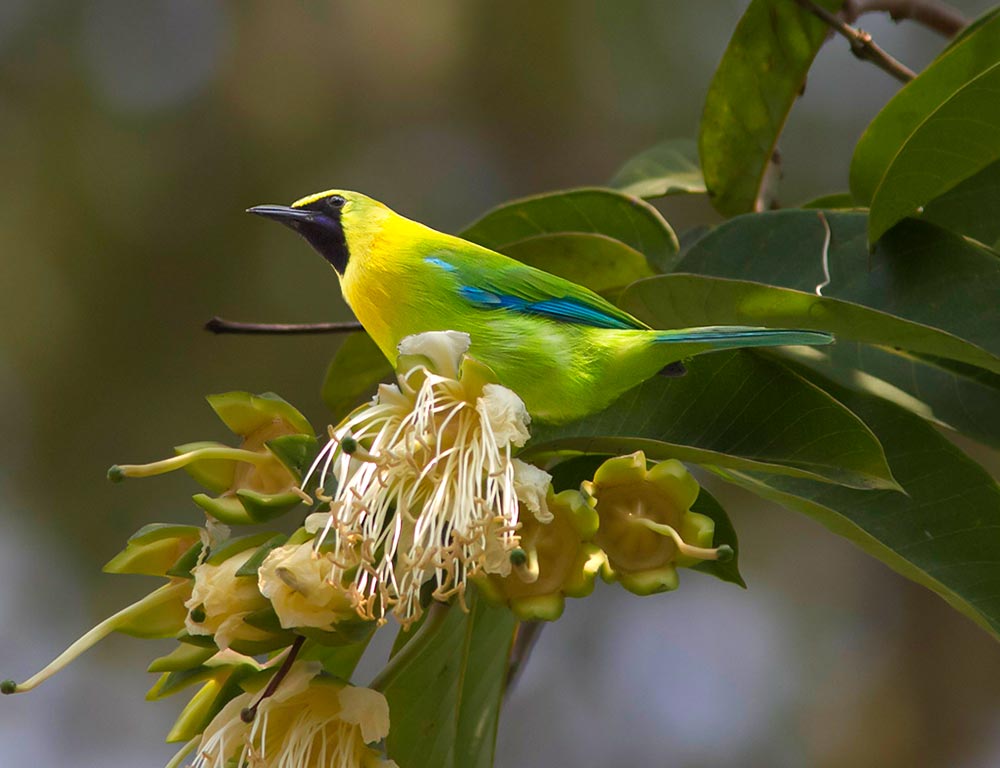
The blue-winged leafbird is a unique species of small, brightly-colored passerine birds, native to Southeast Asia.
They are found in a variety of habitats, including dense forests and secondary growth areas, ranging from as far east as Borneo to as far south as southern Sumatra.
They are easily recognized by their striking blue wings, which contrast with the yellow-green feathers on the rest of their body. These birds are also recognizable by their distinctively long tail, which they often fan out while perched.
They mainly feed on insects, berries, and fruit, and produce melodies of chirps and trills. Although their population is believed to be stable, they are still considered threatened by habitat destruction and fragmentation of their natural habitats.
| Kingdom | Animalia |
| Phylum | Chordata |
| Class | Aves |
| Order | Passeriformes |
| Family | Chloropseidae |
| Genus | Chloropsis |
| Species | C. moluccensis |
11. Black-breasted Weaver
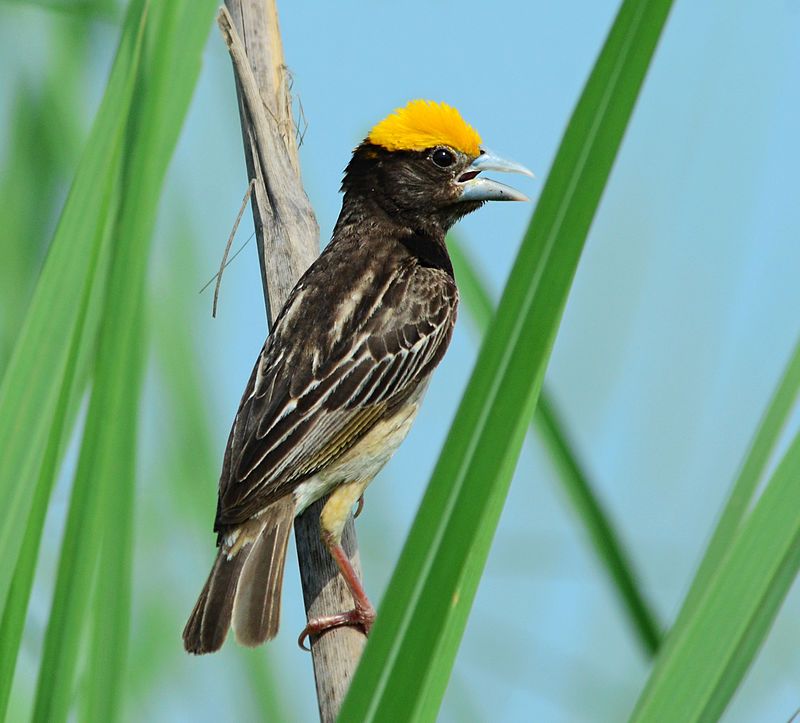
The black-breasted weaver, also known as the Bengal weaver or black-throated weaver, is a small passerine bird native to the Indian subcontinent.
This species is widespread in the northern river plains of the subcontinent and is often found in man-made habitats such as villages and agricultural areas. It is a small bird, measuring just 13 cm in length, with a short tail and wings.
Its plumage is predominantly black, with a brownish-black throat and breast, and yellow belly. It is mostly found in flocks and feeds mainly on insects and other small invertebrates.
The black-breasted weaver is an adaptable species and can survive in a wide variety of habitats, including woodlands, grasslands, and wetlands.
It is also a very vocal species, producing a range of melodious vocalizations, which it uses to communicate with other members of its species.
The black-breasted weaver is an important species in the local ecology, as it plays an important role in the dispersal of seeds and the spread of vegetation. This species is listed as Least Concern on the IUCN Red List.
| Kingdom | Animalia |
| Phylum | Chordata |
| Class | Aves |
| Order | Passeriformes |
| Family | Ploceidae |
| Genus | Ploceus |
| Species | P. benghalensis |
12. Blossom-headed Parakeet
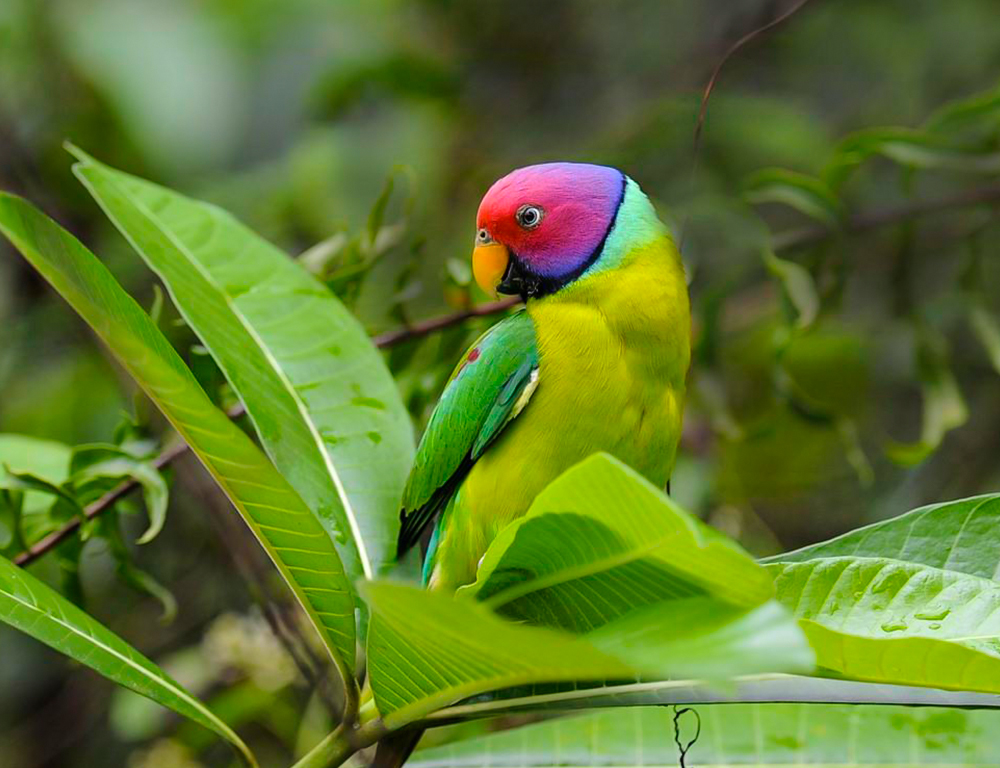
The blossom-headed parakeet is a species of parrot that belongs to the family Psittaculidae. It is an attractive small bird with a bright green body, a blue head, and a pink and yellow beak.
The blossom-headed parakeet is native to India and Southeast Asia, but it is also found in some parts of Africa and Madagascar. This species of parrot is known for its intelligence and playful nature, and it is often kept as a pet.
It is a social bird that prefers to live in flocks and can be seen in woodlands, scrubland, and urban areas. The blossom-headed parakeet is omnivorous, meaning it eats both plants and animals, but its diet mainly consists of fruits, nuts, and seeds.
It is also known to eat insects and small reptiles. This species of parrot is currently listed as Least Concern on the IUCN Red List, however, its population is declining due to deforestation, hunting, and the pet trade.
Therefore, it is important to ensure that the blossom-headed parakeet is protected and its habitat is preserved.
| Kingdom | Animalia |
| Phylum | Chordata |
| Class | Aves |
| Order | Psittaciformes |
| Family | Psittacidae |
| Genus | Himalayapsitta |
| Species | H. roseata |
13. Blunt-winged Warbler
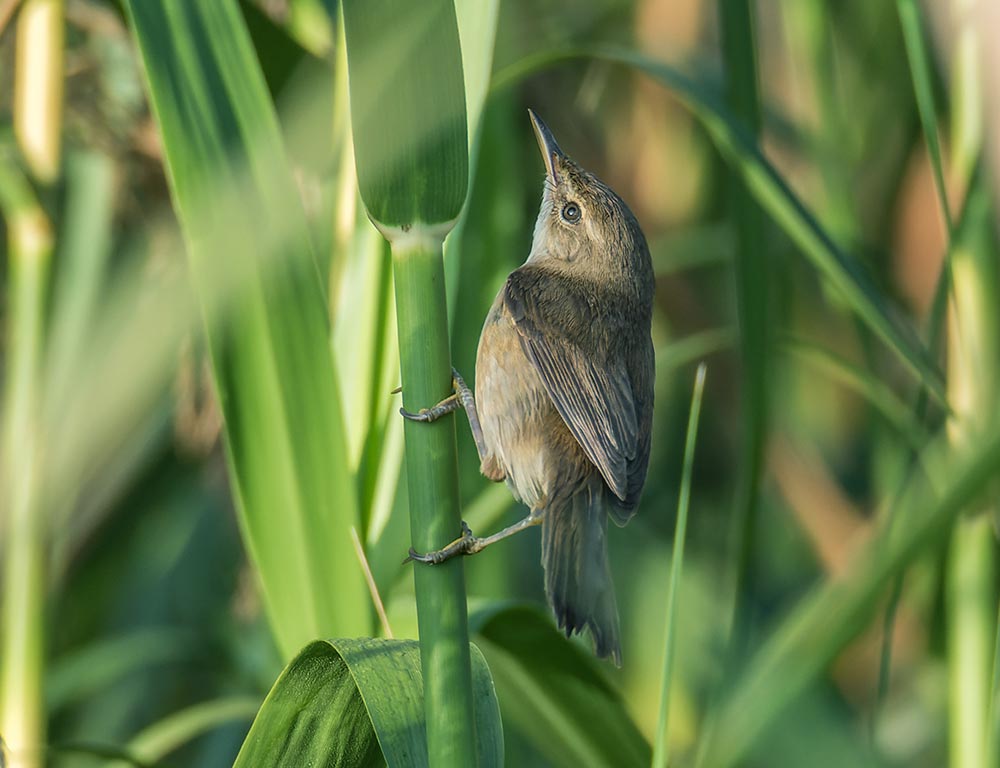
The Blunt-winged Warbler is a species of marsh-warbler, first described by Robert Swinhoe in 1870. Before this, it was placed in the Old World Warbler assemblage, which is a group that includes a variety of songbirds.
It is native to Afghanistan, Pakistan, India, and China, and during the winter months, it migrates to countries such as Myanmar, Thailand, and Bangladesh. The Blunt-winged Warbler is a small bird, typically measuring between 11 and 12 cm in length.
It is olive-brown, with a white belly and dark stripes across its wings. Its bill is short and stubby, and its tail is short and often cocked.
It has a loud and melodic call which is often heard in its native habitats. The Blunt-winged Warbler can be found in marshy areas, such as damp grassland and reedbeds.
It feeds mainly on insects, larvae, and other invertebrates, which it searches for amongst vegetation.
During the breeding season, it builds a cup-shaped nest, made from grass and other plant material, which it places in a bush or shrub.
The female usually lays a clutch of four or five eggs, which are incubated by both parents for around two weeks. The Blunt-winged Warbler is an adaptable species that is not considered to be threatened with extinction.
However, its numbers have declined in some areas due to the destruction of its habitats. Conservation efforts are therefore necessary to protect this species and its habitats.
| Kingdom | Animalia |
| Phylum | Chordata |
| Class | Aves |
| Order | Passeriformes |
| Family | Acrocephalidae |
| Genus | Acrocephalus |
| Species | A. concinens |
14. Black-backed Forktail
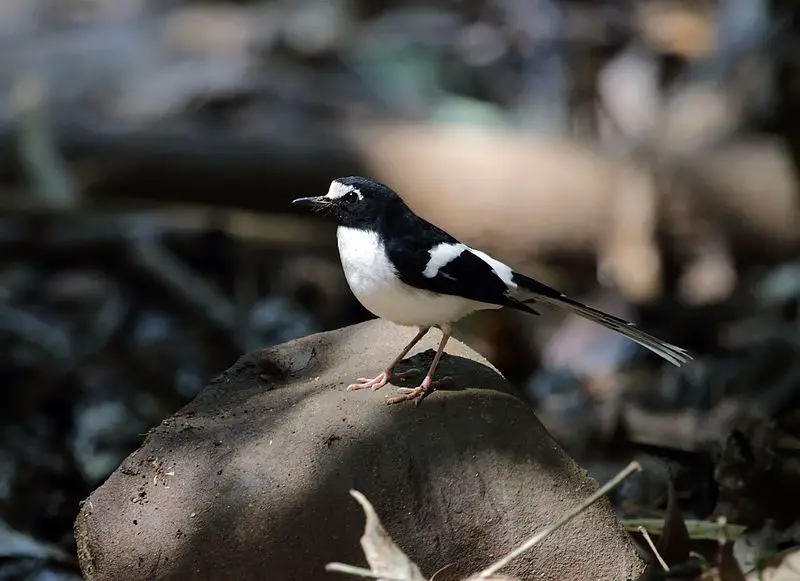
The black-backed forktail is a species of forktail found in the family Muscicapidae. Its scientific name is derived from its original description from a specimen found in Nepal in 1836.
This species is a medium-sized bird, measuring between 20.5 and 23 centimetres in length, and weighing between 25 and 29 grams. Its plumage is predominantly black, with a black throat and a white belly. The tail is forked, with the tip of the tail feathers being white.
The black-backed forktail is a fairly common species, found in parts of India, Nepal, and Bhutan. It inhabits grasslands, wetlands, and scrublands, and feeds on insects, spiders, and other invertebrates. It is a territorial species and is usually seen in pairs or small groups.
| Kingdom | Animalia |
| Phylum | Chordata |
| Class | Aves |
| Order | Passeriformes |
| Family | Muscicapidae |
| Genus | Enicurus |
| Species | E. immaculatus |
15. Brown-capped Laughingthrush
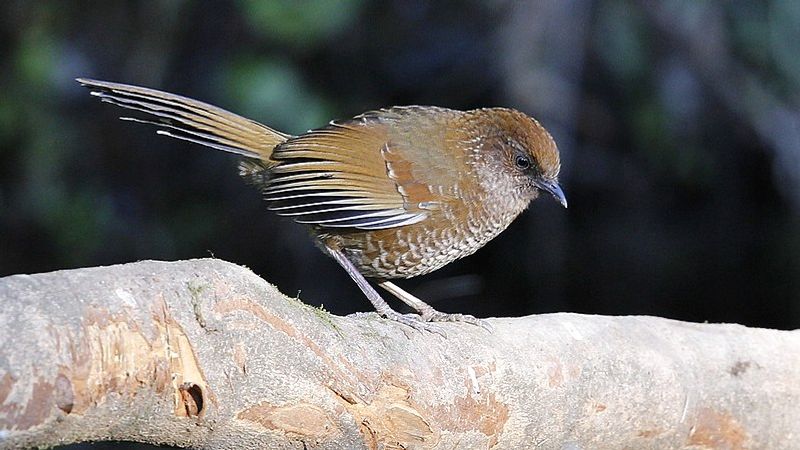
The brown-capped laughingthrush is a type of bird that is part of the Leiothrichidae family. It is native to the Patkai range, which is a mountain range located in Northern India and Burma.
The bird lives in subtropical and tropical moist montane forests, which are forests that are located in mountainous regions and have a high level of humidity. These forests are typically characterized by trees that are evergreen and have thick foliage.
The brown-capped laughingthrush needs these forests because it is an omnivorous bird that feeds on insects, fruits, and seeds. It also depends on the dense foliage of these forests to provide it with protection from predators.
The bird plays an important role in maintaining the balance of the ecosystem in these forests by providing natural pest control and dispersing seeds.
The brown-capped laughing thrush is a vital species in the Patkai range, and its conservation is essential for the health of its natural habitat.
| Kingdom | Animalia |
| Phylum | Chordata |
| Class | Aves |
| Order | Passeriformes |
| Family | Leiothrichidae |
| Genus | Trochalopteron |
| Species | T. austeni |
16. Blue Pitta
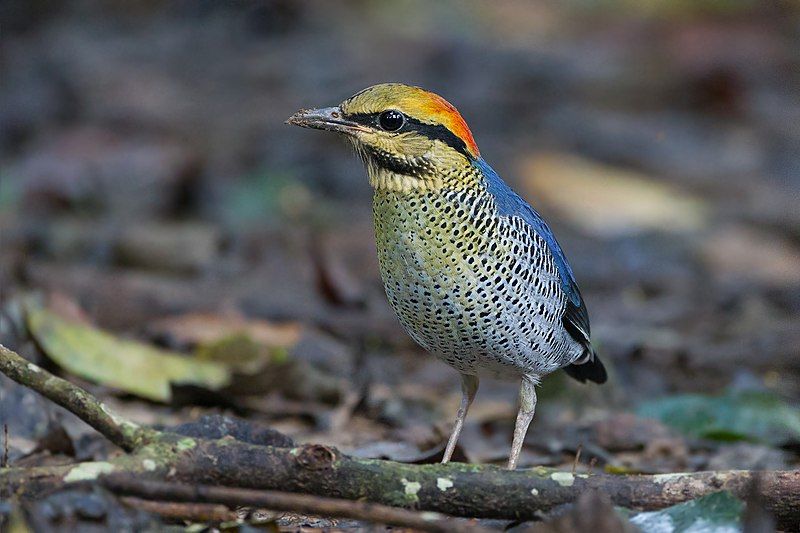
The blue pitta is a species of bird that belongs to the Pittidae family, which is native to the northeastern Indian subcontinent, southern China, and Indochina. It has a bright blue plumage, hence its name.
This bird prefers to inhabit moist forests but is also known to make its home in dry forests. It is an omnivore, meaning it feeds on both plant and animal material. The blue pitta is known for its vocalizations, and it is often heard singing during the breeding season.
Its diet consists of insects, fruits, seeds, and some small vertebrates such as lizards. The blue pitta is a solitary bird, but during the breeding season, pairs can be seen in the same area.
They build their nests in tree cavities, and the female lays two to four eggs at a time. The blue pitta is an important species for the forests it inhabits, as it helps disperse seeds and control insect populations.
It is also an important symbol of biodiversity in the region and is a species of concern due to the threat of habitat loss.
| Kingdom | Animalia |
| Phylum | Chordata |
| Class | Aves |
| Order | Passeriformes |
| Family | Pittidae |
| Genus | Hydrornis |
| Species | H. cyaneus |
17. Black-eared Shrike-babbler
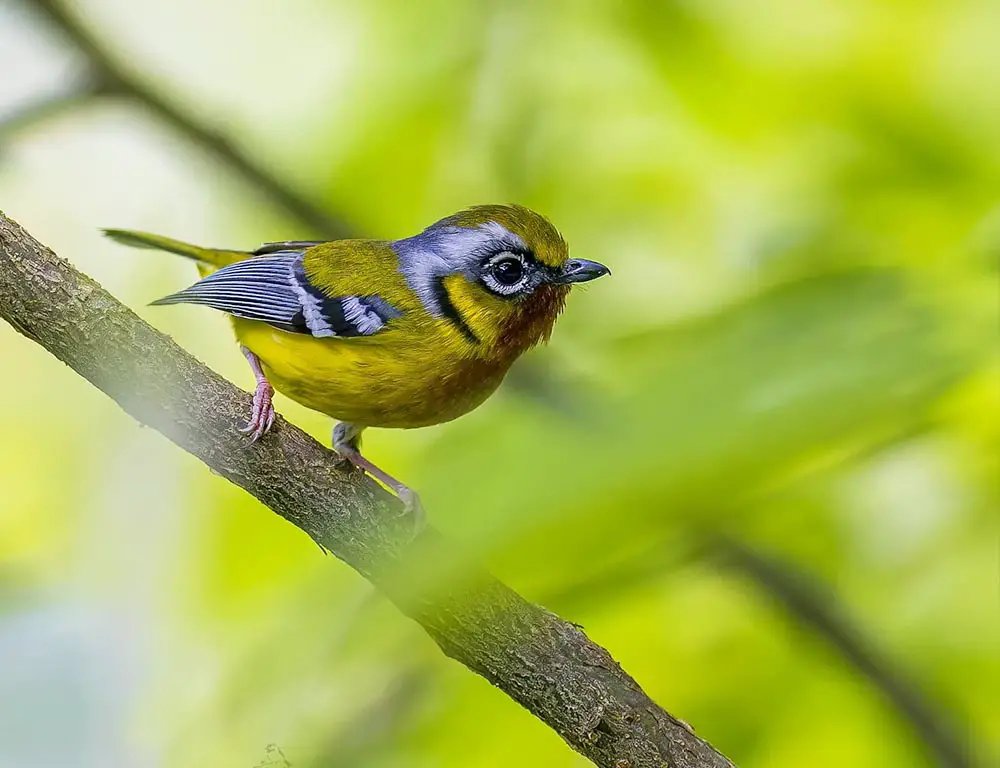
The black-eared shrike-babbler is a medium-sized bird species belonging to the vireo family, Vireonidae. This species is found in the Indian subcontinent and has a distinctive black ear patch and a white throat.
The black-eared shrike-babbler is known for its vocalizations which include a loud, sharp call.
It is also known to be very active and is often seen hopping between trees. Historically, the black-eared shrike-babbler was considered to be an aberrant Old World babbler and was placed in the family Timaliidae.
This is because of its resemblance to both Old World babblers and Vireonidae, as it has some characteristics of both families.
However, due to further research and study, it has now been established that the black-eared shrike-babbler is indeed a member of the Vireonidae family.
This is largely due to its close resemblance to other members of the Vireonidae family and its distinct behavior.
The black-eared shrike-babbler is an important species in its native habitat, as it helps to maintain the local ecosystem by providing food for other birds and animals.
It is also a popular bird among birdwatchers, due to its unique characteristics and its vibrant colors.
| Kingdom | Animalia |
| Phylum | Chordata |
| Class | Aves |
| Order | Passeriformes |
| Family | Vireonidae |
| Genus | Pteruthius |
| Species | P. melanotis |
18. Buff-breasted Babbler
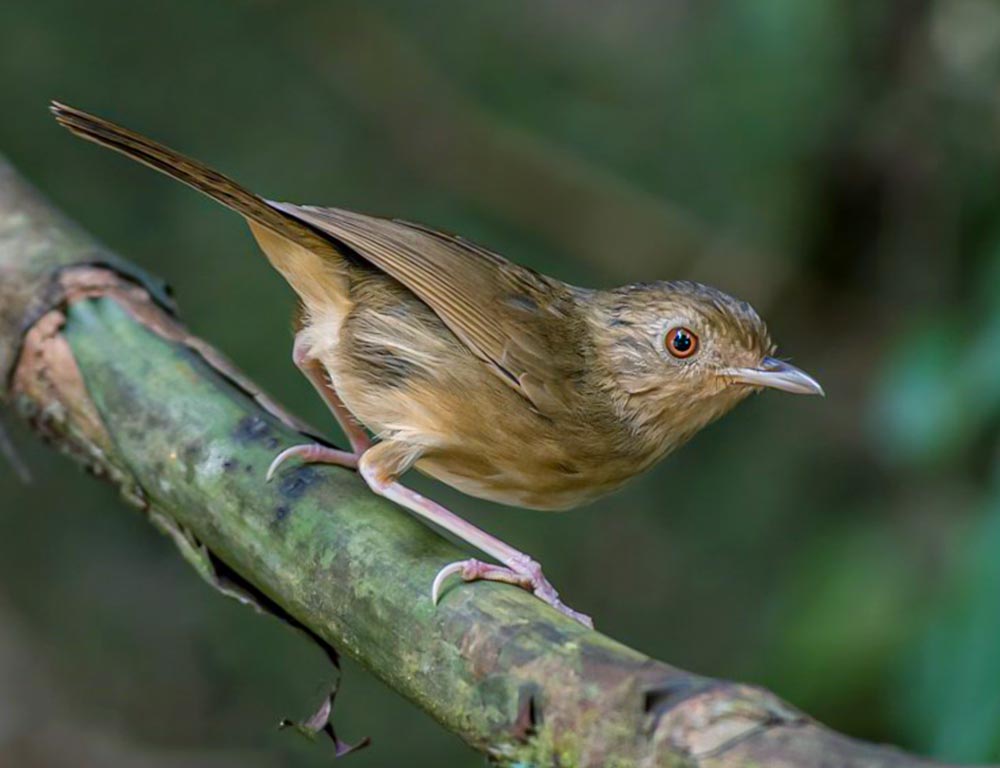
The buff-breasted babbler is a species of small bird that is native to a wide variety of countries throughout South and Southeast Asia. This bird is part of the family Pellorneidae, which includes a variety of birds that are closely related to each other.
The buff-breasted babbler is found in Bangladesh, Cambodia, China, India, Laos, Malaysia, Myanmar, Thailand, and Vietnam.
The buff-breasted babbler lives in a variety of habitats, including subtropical and tropical moist lowland forests and subtropical and tropical moist montane forests.
The lowland forests are found in the valleys and lowlands of the countries in which the buff-breasted babbler resides, while the montane forests are found in the mountainous regions.
Both of these habitats provide the bird with plenty of food, shelter, and nesting options, making it a successful species in the areas in which it lives. The buff-breasted babbler is an omnivore, meaning it feeds on both plants and small animals.
This includes insects, fruits, and other plant matter. The bird also takes part in communal activities, such as flocking with other species of birds in its habitat. This helps to protect the bird from predators, as there are more eyes on the lookout for potential danger.
Overall, the buff-breasted babbler is an adaptable species that can be found in a variety of habitats in South and Southeast Asia. Its omnivorous diet and communal behavior have allowed the species to become successful in the areas in which it resides.
| Kingdom | Animalia |
| Phylum | Chordata |
| Class | Aves |
| Order | Passeriformes |
| Family | Pellorneidae |
| Genus | Pellorneum |
| Species | P. tickelli |
19. Black-breasted Thrush
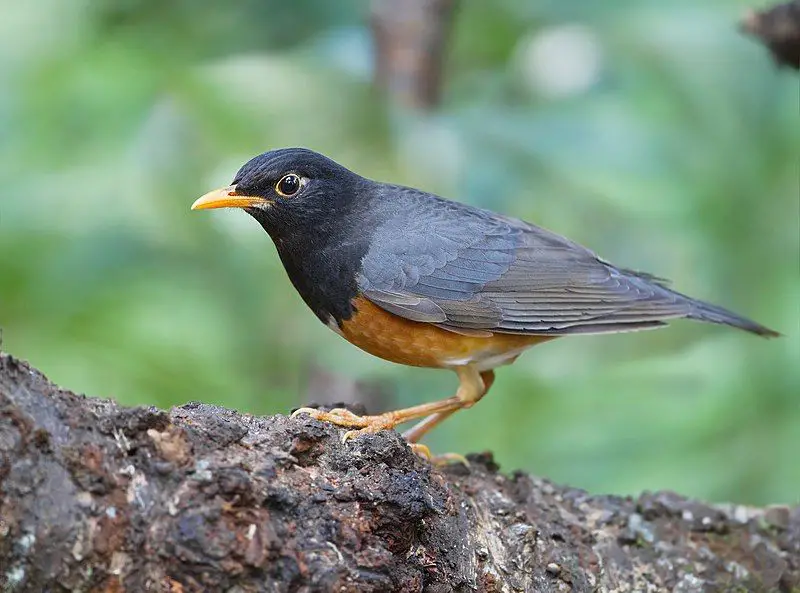
The black-breasted thrush is a species of bird that belongs to the family Turdidae. It is mainly found in the area stretching from north-eastern India to northern Vietnam. Both male and female birds of this species have the same color on their lower parts.
However, the upper section of the male black-breasted thrush is mostly black, while the female bird has a grey-brown coloration.
The black-breasted thrush is a medium-sized bird, with a length of about 20-24 cm. Its wingspan is around 31-35 cm and the bird weighs about 28-36 g.
The male bird has an intense black coloration on its wings and tail and its breast and head are also black.
The female bird has a grey-brown color on its wings and tail and its breast and head are greyish-brown in colour. The black-breasted thrush is a solitary bird and it mainly feeds on fruits, insects, and small vertebrates like lizards.
It is a vocal bird and it often sings while perched on tree branches.
The black-breasted thrush is a migratory species and it usually migrates from the northern parts of India and Vietnam to south-eastern areas during the winter season. The black-breasted thrush is an important species of bird as it plays a significant role in the food web of its habitat.
It is a valuable species for the ecosystem and its conservation is important for the health of the environment.
| Kingdom | Animalia |
| Phylum | Chordata |
| Class | Aves |
| Order | Passeriformes |
| Family | Turdidae |
| Genus | Turdus |
| Species | T. dissimilis |
20. Black-chinned Yuhina
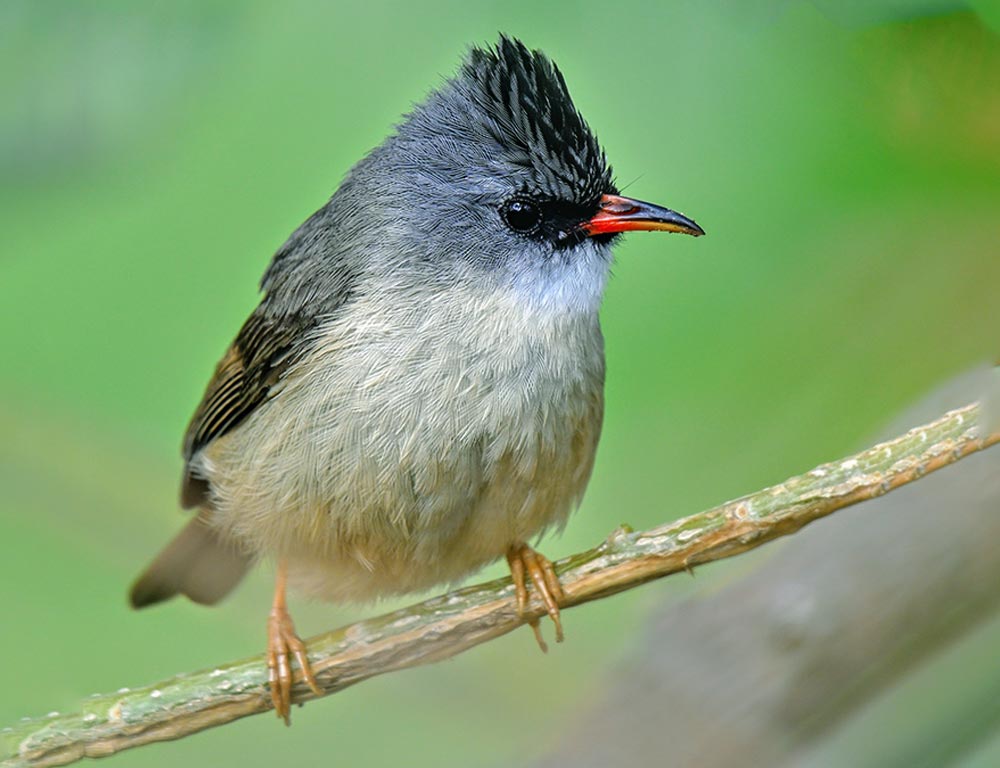
The black-chinned yuhina is a small bird species that belongs to the white-eye family Zosteropidae. It is native to the Indian subcontinent, where it can be found in the Himalayan mountains, as well as in hilly regions of Southeast Asia.
Its range covers a large area, from Bangladesh in the east, Bhutan in the south, Cambodia to the west, India, Laos, Myanmar, Nepal, Tibet and Thailand. This species is usually found in woodland and scrub habitats, and it mainly feeds on insects.
It has a black chin and throat, and its body is light brownish grey with a yellowish breast and white belly. It has a rapid, buzzing flight and a rather long, thin bill.
The black-chinned yuhina is a social bird, often seen in small flocks, and it can often be heard singing its distinct song.
| Kingdom | Animalia |
| Phylum | Chordata |
| Class | Aves |
| Order | Passeriformes |
| Family | Zosteropidae |
| Genus | Yuhina |
| Species | Y. nigrimenta |
21. Brown-breasted Flycatcher
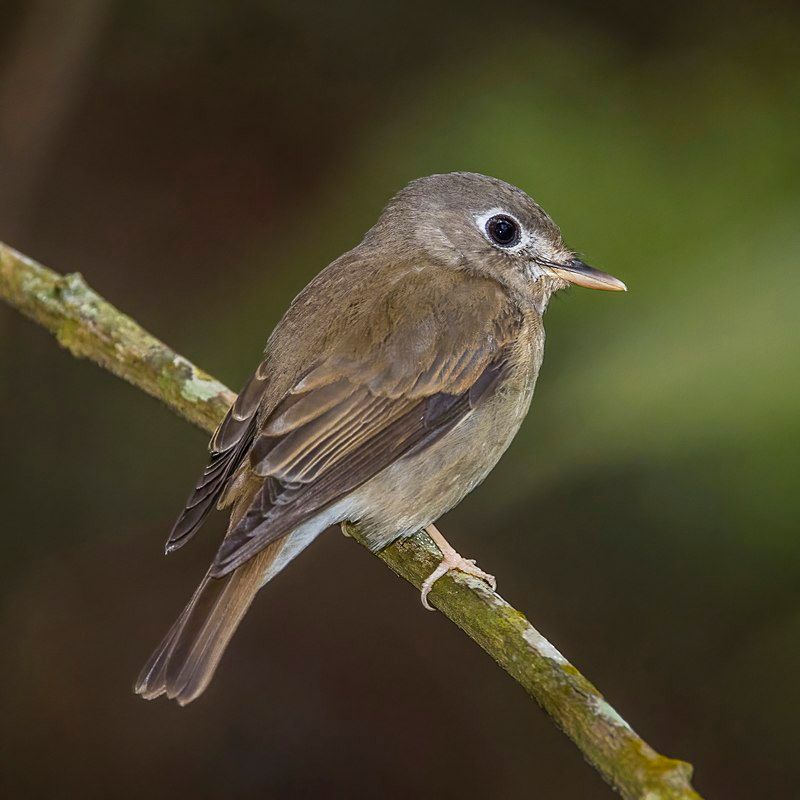
The brown-breasted flycatcher, also known as Layard’s flycatcher, is a small bird belonging to the Muscicapidae family. It is native to northeastern India, Central and Southern China, northern Burma, and Thailand.
During the colder months, the species migrates to southern India and Sri Lanka. The brown-breasted flycatcher is a small passerine bird with a brown breast and a greyish-brown back.
It has a short, stout bill and a distinctive white stripe that runs from the bill to the nape of its neck. It has a greyish-white throat and tail feathers that are tipped with white.
Its wings are short and rounded and its legs are short and yellow. The brown-breasted flycatcher typically feeds on insects, which it catches in mid-air or on the ground. It also eats small fruits and berries.
During the breeding season, it builds a cup-shaped nest in a tree or bush. The female will lay 2 to 4 white eggs, which she incubates for about two weeks.
Once the young birds hatch, both parents take turns feeding them until they are ready to leave the nest. The brown-breasted flycatcher is an important part of the ecosystem, as its diet helps to control insect populations.
It is also an important indicator of the health of its habitat, as it is sensitive to changes in its environment. Unfortunately, the species is threatened by habitat loss and is listed as Vulnerable on the IUCN Red List.
Conservation efforts are needed to protect this species and ensure its survival.
| Kingdom | Animalia |
| Phylum | Chordata |
| Class | Aves |
| Order | Passeriformes |
| Family | Muscicapidae |
| Genus | Muscicapa |
| Species | M. muttui |
22. Brown-flanked Bush Warbler
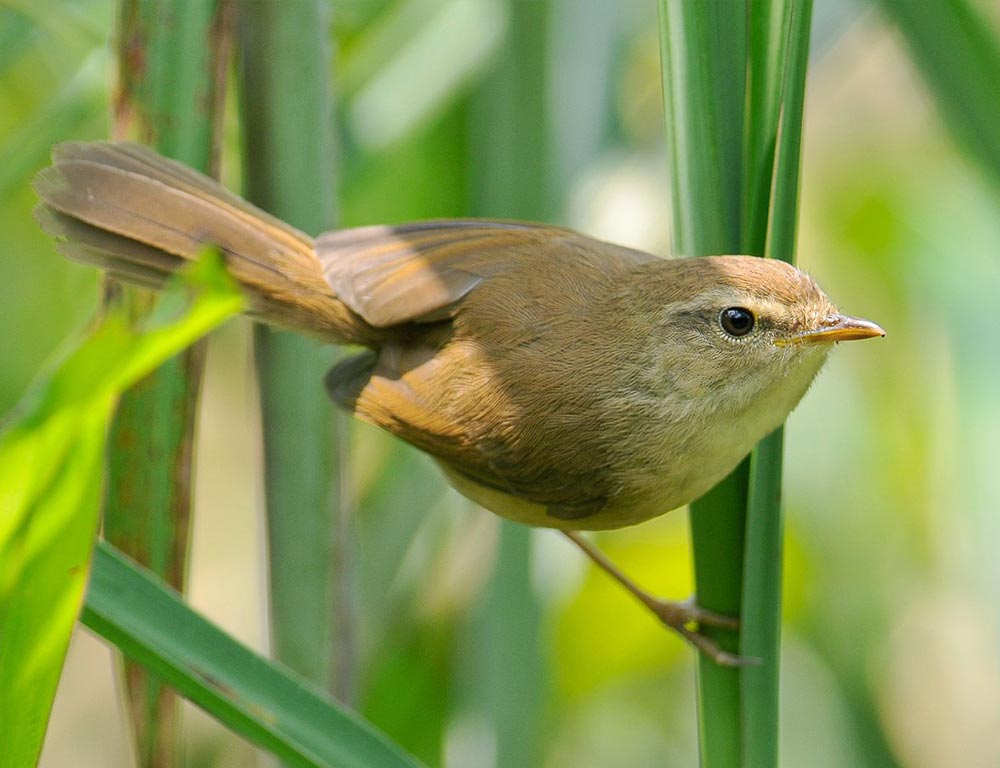
The brown-flanked bush warbler is a species of bush warbler belonging to the family Cettiidae. It is typically found in South Asia and is commonly referred to as the brownish-flanked bush warbler.
This species was formerly included in the “Old World warbler” assemblage, which comprises various species of songbirds.
It is small in size, typically having a brownish-grey back, with a buff-white or yellowish underside. Its tail is usually brown, with two white wing bars.
The brown-flanked bush warbler has a distinct song, which is a mix of long, repetitive phrases and a loud chattering call. Its diet consists mainly of insects, and it typically builds its nest in low shrubs or trees.
The brown-flanked bush warbler is an important species in helping to maintain the balance of its local ecosystem, by controlling insect populations and dispersing seeds.
| Kingdom | Animalia |
| Phylum | Chordata |
| Class | Aves |
| Order | Passeriformes |
| Family | Cettiidae |
| Genus | Horornis |
| Species | H. fortipes |
23. Blyth’s Swift
Blyth’s Swift is a small bird that looks similar to a house martin. However, these two species are not related. This is because Blyth’s swift belongs to the order Apodiformes, which is a different classification of bird.
The resemblances between these two species are not due to any shared ancestry or genetic similarities, but instead are the result of convergent evolution.
This is when two species of unrelated organisms independently evolve similar traits to adapt to similar environments and lifestyles.
In this case, both the house Martin and the Blyth’s Swift have adapted to a lifestyle of spending a lot of time in the air, and the similarities in their physical appearance are simply the result of this convergence.
| Kingdom | Animalia |
| Phylum | Chordata |
| Class | Aves |
| Clade | Strisores |
| Order | Apodiformes |
| Family | Apodidae |
| Genus | Apus |
| Species | A. leuconyx |
24. Rufous-necked Hornbill
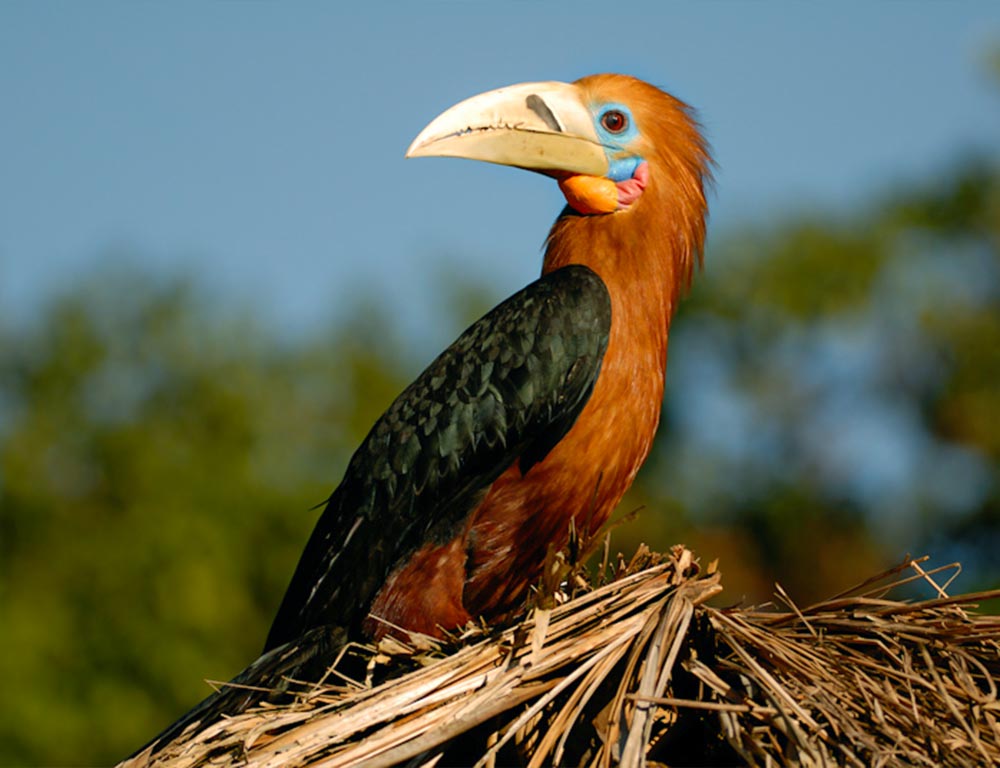
The rufous-necked hornbill is a species of bird native to Bhutan, northeastern India, and Southeast Asia. It is especially found in the Indian state of Arunachal Pradesh.
Unfortunately, this species is now locally extinct in Nepal due to hunting and a significant loss of its natural habitat.
There are now less than 10,000 adults of this species left in the wild, making it a species of conservation concern. Its loss of habitat is largely due to deforestation, which is a consequence of the increase in human population and development in the region.
As a result of this habitat destruction, the rufous-necked hornbill has been forced to a very small area of its original range. Hunting is also a major factor in its dwindling numbers.
Even though hunting of this species is illegal, there is still a significant amount of illegal poaching, which is a major cause of its population decline. The rufous-necked hornbill is a species that needs conservation and protection.
Due to its small population, it is important that its remaining habitat be protected and that hunting of this species is strictly enforced. It is also important to ensure that its habitat is restored so that its population can increase.
Only with concerted efforts from local governments, conservationists, and individuals can these species be saved from extinction.
| Kingdom | Animalia |
| Phylum | Chordata |
| Class | Aves |
| Order | Bucerotiformes |
| Family | Bucerotidae |
| Genus | Aceros |
| Species | A. nipalensis |
25. Great Hornbill
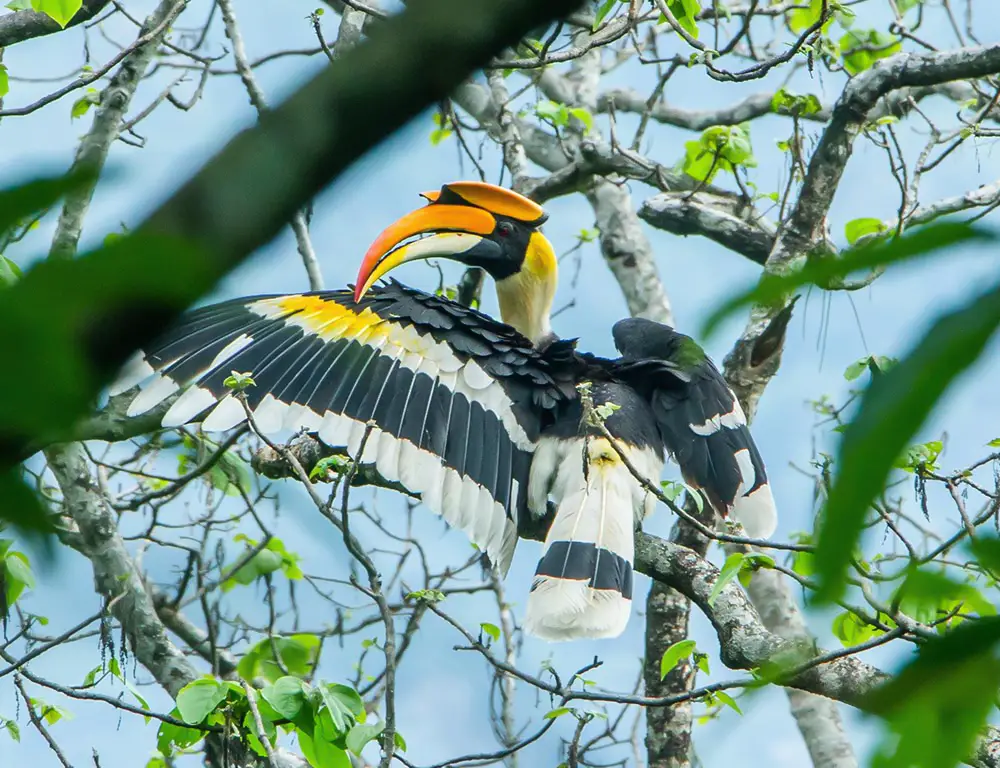
The Great Hornbill is one of the largest birds of the hornbill species. It is native to the Indian subcontinent and Southeast Asia. The exact species is known as the concave-casqued hornbill, great Indian hornbill, or great pied hornbill.
It has a distinctive white and black plumage and a large curved bill. The Great Hornbill mainly feeds on fruits and nuts, but it also preys on small mammals, reptiles, and other birds. Its diet is highly varied, and it can be seen eating insects, seeds, and small vertebrates.
It is a highly territorial bird and is known to fight with other hornbills for food and nesting sites. Its loud call is one of the most recognizable sounds of the jungle.
The Great Hornbill plays an important role in forests, as it is a keystone species that help to disperse seeds and maintain the local ecosystem.
| Kingdom | Animalia |
| Phylum | Chordata |
| Class | Aves |
| Order | Bucerotiformes |
| Family | Bucerotidae |
| Genus | Buceros |
| Species | B. bicornis |
26. Ward’s Trogon
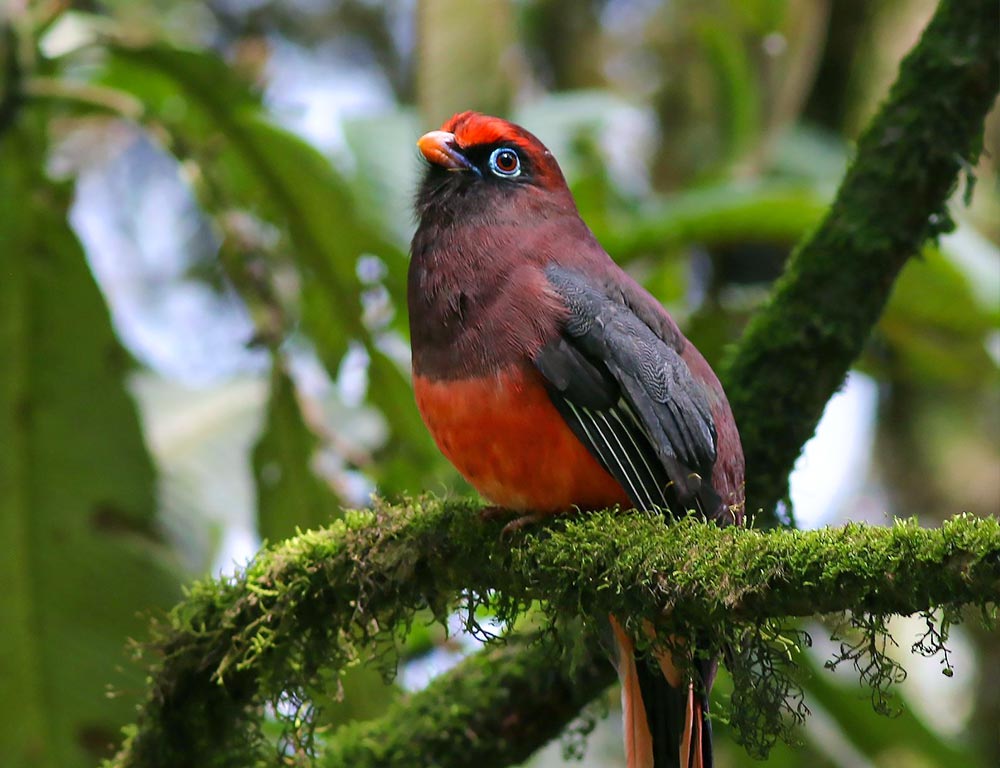
Ward’s trogon is a species of bird that belongs to the Trogonidae family. It is found in the northeastern parts of the Indian subcontinent, stretching eastwards to Southeast Asia. The specific countries in which this bird is found are Bhutan, India, Tibet, and Myanmar.
Additionally, there is a disjunct population in northern Vietnam, but it has not been recorded in that area recently. This species of bird has an impressive range, spanning across multiple countries in the Asian continent.
It is typically found in humid subtropical and tropical moist montane forests, but it can also be spotted in more open woodland areas. Its diet consists of insects and small fruits, which it obtains by foraging from the canopy.
Ward’s trogon is a medium-sized bird with a distinctive orange-red breast, a black head, and a yellow bill, making it a highly recognizable species in its range.
| Kingdom | Animalia |
| Phylum | Chordata |
| Class | Aves |
| Order | Trogoniformes |
| Family | Trogonidae |
| Genus | Harpactes |
| Species | H. wardi |
27. Wreathed Hornbill
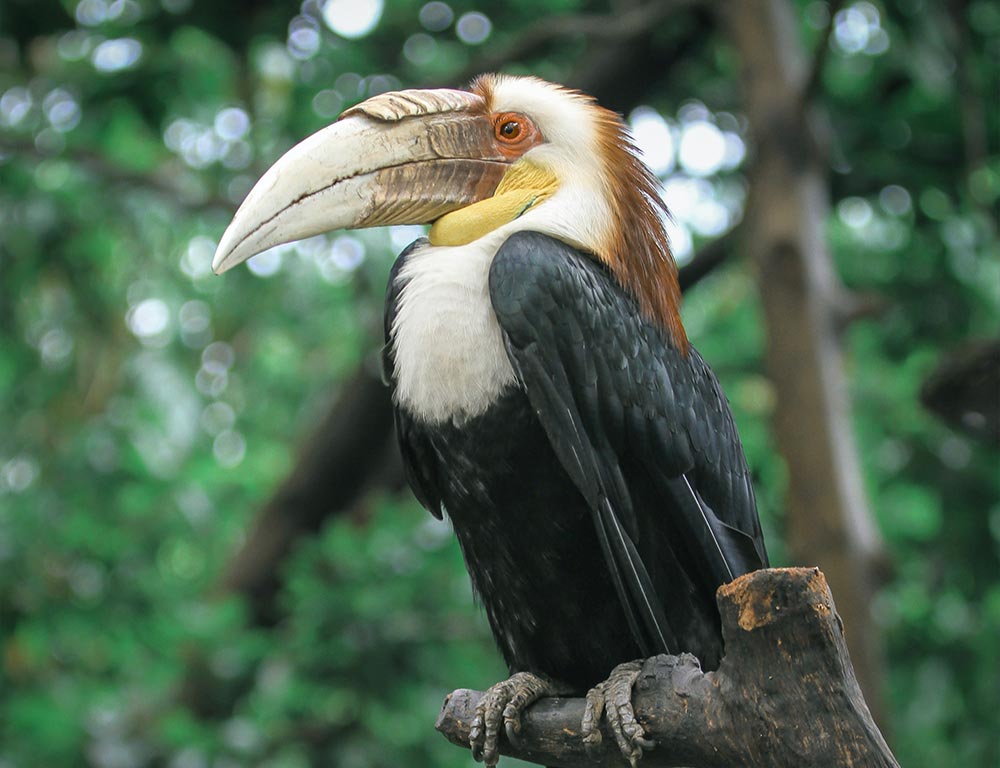
The wreathed hornbill is a large, tropical bird that can be found in the Old World. It is part of the hornbill family, Bucerotidae, and is also known as the bar-pouched wreathed hornbill. This bird is easily recognized by its distinctive blue-black band on its lower throat sac.
This band is composed of feathers that give the bird a unique and attractive look. The wreathed hornbill is a large bird, reaching up to 19 inches long and having a wingspan of around 30 inches. Its bill is curved and can be used for digging and foraging for food.
The female wreathed hornbill is mainly brown with some white spots on her wings and tail. The male bird is more striking, with a black head and neck, a white throat and breast, and a black and white barred tail. Both sexes have a yellow bill and legs.
The wreathed hornbill can be found in the tropical regions of the Old World, including parts of Africa, Southeast Asia, and the Indian subcontinent.
They live in tropical forests, often near rivers and streams, where they feed on fruit, insects, small animals, and other small creatures. They are also known to have a loud, raucous call that can be heard from up to a mile away.
| Kingdom | Animalia |
| Phylum | Chordata |
| Class | Aves |
| Order | Bucerotiformes |
| Family | Bucerotidae |
| Genus | Rhyticeros |
| Species | R. undulatus |
28. Green-billed Malkoha
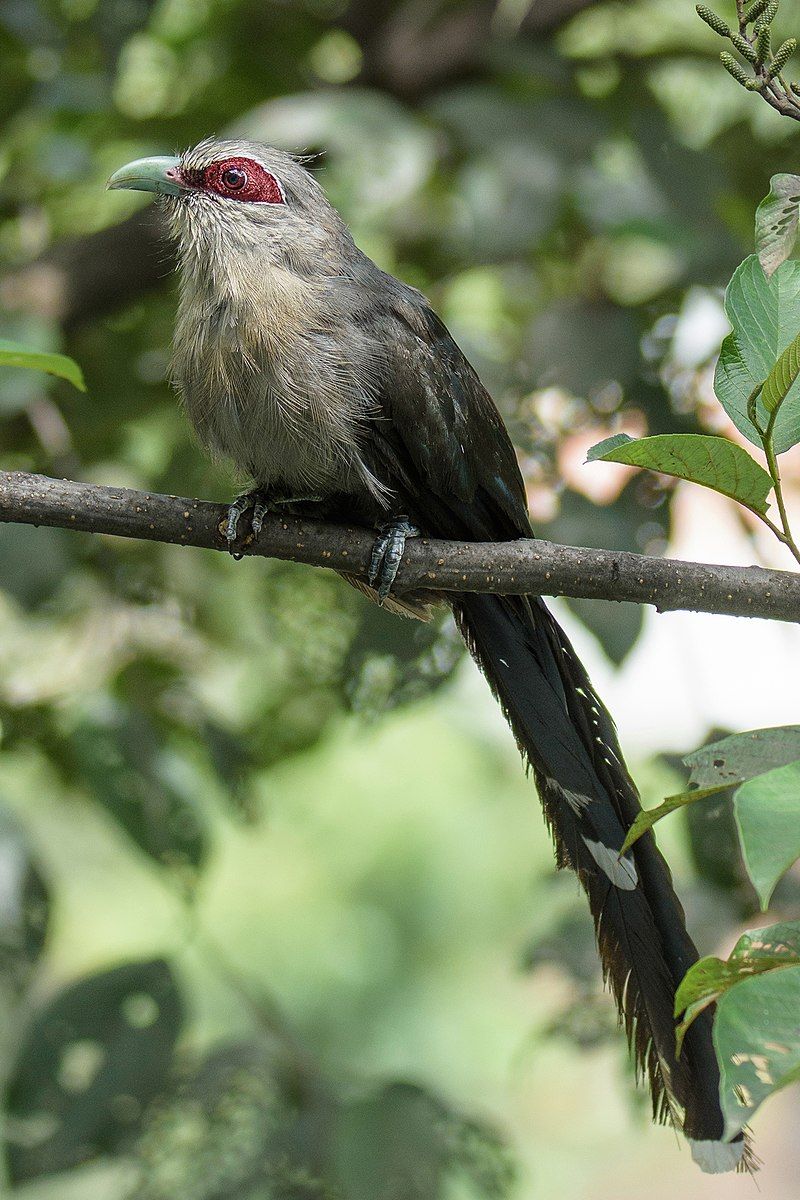
The green-billed malkoha is a unique species of non-parasitic cuckoo that is found throughout the Indian Subcontinent and Southeast Asia. These birds stand out due to their waxy bluish-black feathers that are complemented by a long, graduated tail with white tips.
The bill of the bird is also quite prominent and curved, making it an easily recognizable species. The green-billed malkoha prefers to inhabit dry scrub and thin forests, taking advantage of the abundant supply of food and the cover that these habitats offer.
They can often be seen foraging on the ground, in search of insects, small reptiles, and other invertebrates. These birds are also known to eat fruits and seeds, which provide them with essential nutrients.
The green-billed malkoha is a unique species that is found throughout the Indian Subcontinent and Southeast Asia. With its waxy bluish-black feathers and long, graduated tail, it is easily recognizable.
This species prefers to inhabit dry scrub and thin forests, where it can find a plentiful supply of food. The green-billed malkoha is a fascinating species that is worth learning more about.
| Kingdom | Animalia |
| Phylum | Chordata |
| Class | Aves |
| Order | Cuculiformes |
| Family | Cuculidae |
| Genus | Phaenicophaeus |
| Species | P. tristis |
29. White-winged Duck
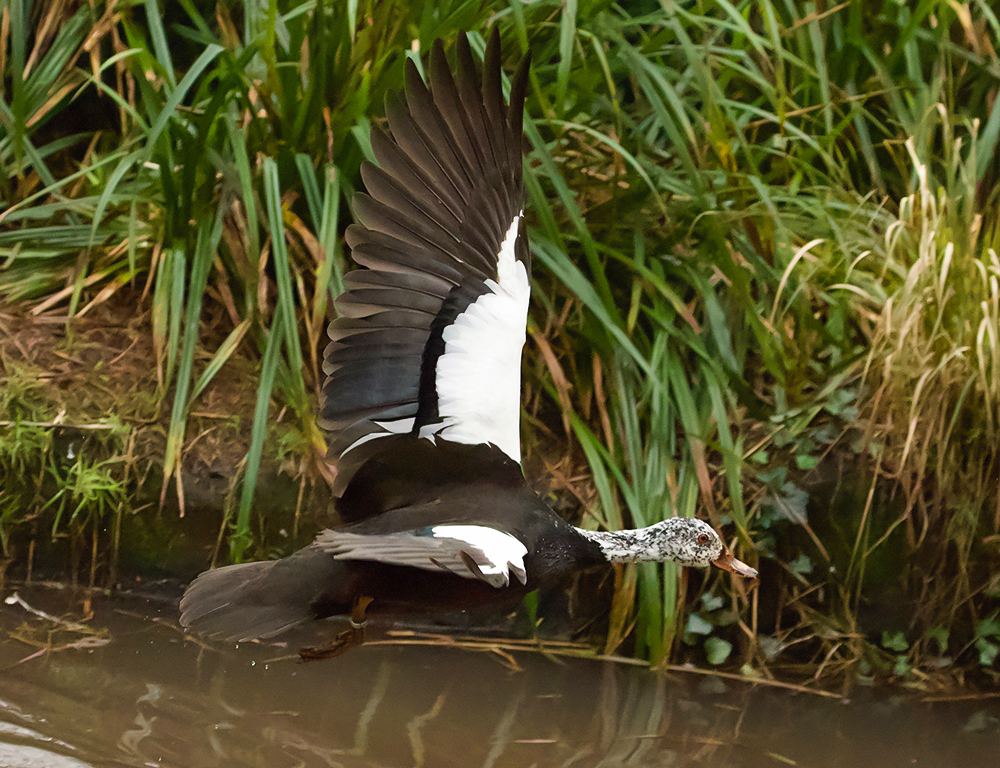
The white-winged duck, also known as the white-winged wood duck, is a large species of duck that is native to parts of Africa, Asia, and Europe. It is closely related to the Muscovy duck, which is also part of the same genus, Cairina.
This species of duck is a dabbling duck, meaning that it feeds on the surface of the water, typically by tipping its head underwater and searching for food.
The white-winged duck is thought to be one of the most ancient species of duck, having been around since the Miocene period. It is an impressive species and can reach up to 30 inches in length with a wingspan of nearly five feet.
Its striking white wing feathers make it easily distinguishable from other species of ducks. The white-winged duck is a monogamous species, and typically nests in hollow tree cavities or abandoned nests of other birds.
| Kingdom | Animalia |
| Phylum | Chordata |
| Class | Aves |
| Order | Anseriformes |
| Family | Anatidae |
| Genus | Asarcornis |
| Species | A. scutulata |
30. White-bellied Heron
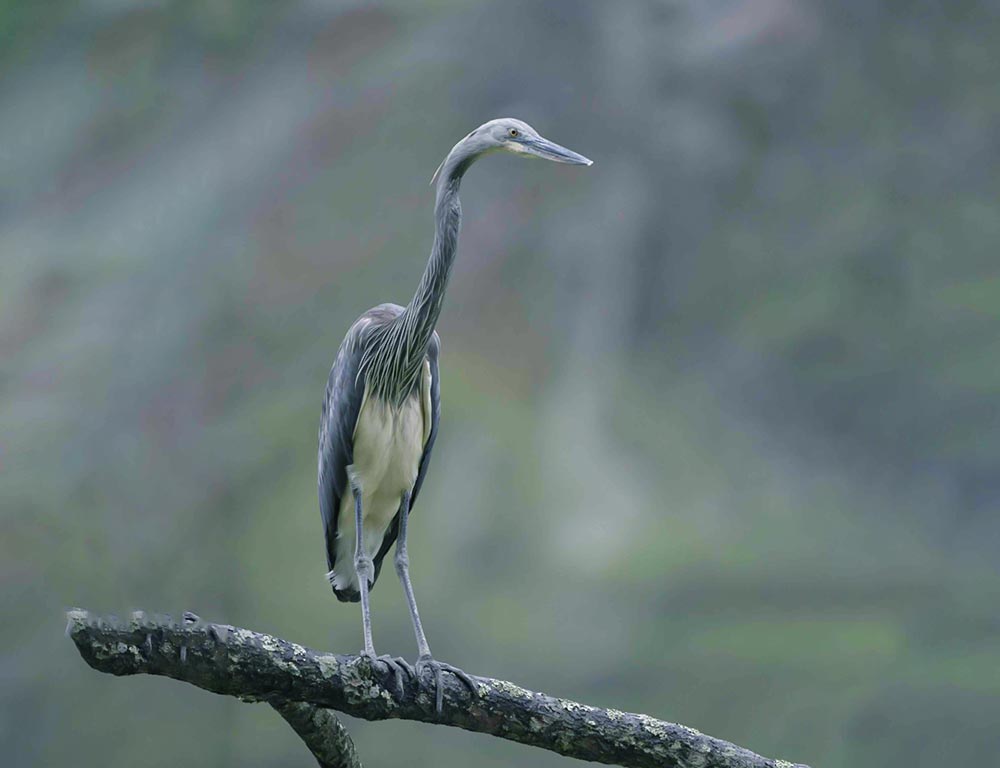
The White-Bellied Heron, also known as the Imperial Heron or Great White-Bellied Heron, is a species of large heron that inhabits the foothills of the Eastern Himalayas in the countries of Northeast India, Bhutan, and Northern Myanmar.
It is found in areas that are relatively undisturbed, such as rivers and wetlands, and it is rarely seen in heavily populated areas. The White-Bellied Heron has a unique appearance that sets it apart from other herons.
It is larger than most heron species, with a long neck and a white belly that stands out against its dark gray feathers.
It also has a distinctive white head and is often seen standing motionless in the shallow waters of its habitat. The White-Bellied Heron is a solitary bird and typically avoids contact with other herons.
It feeds mainly on fish, but it may also feed on amphibians, reptiles, and invertebrates. It prefers to hunt in the morning and evening when the light is at its best. The White-Bellied Heron is under threat from habitat loss and hunting.
It is classified as Near Threatened on the IUCN Red List of Threatened Species, and its population is decreasing. Conservation efforts are needed to ensure its survival in the wild.
| Kingdom | Animalia |
| Phylum | Chordata |
| Class | Aves |
| Order | Pelecaniformes |
| Family | Ardeidae |
| Genus | Ardea |
| Species | A. insignis |
31. Spotted Laughingthrush
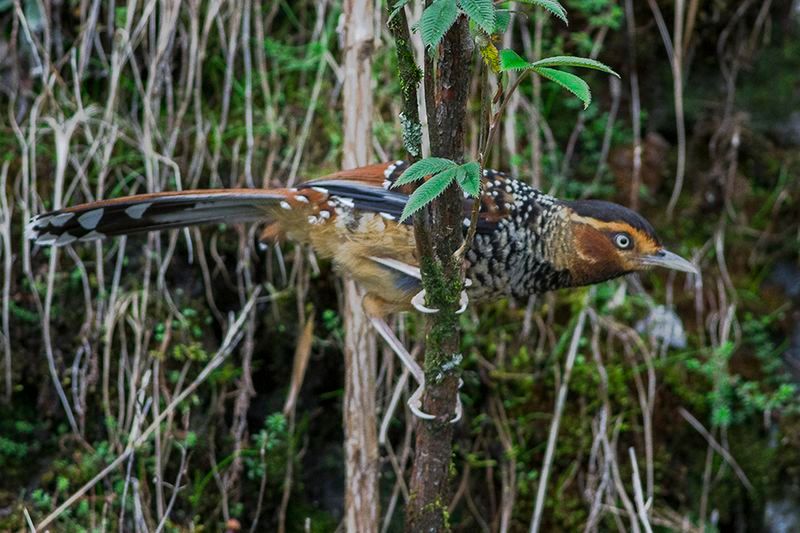
The spotted laughingthrush is a bird species belonging to the Leiothrichidae family. This species is found in five countries: Bhutan, China, India, Myanmar, and Nepal.
It prefers to inhabit subtropical or tropical moist montane forests, which provide plenty of cover for the bird and its nest.
The spotted laughingthrush is a small bird, measuring up to 18 cm. It has mainly gray-brown upperparts and white underparts with dark spots.
The male has a black throat and face, while the female lacks this feature. Its diet consists of insects, fruits, and berries. The spotted laughingthrush is an important species in its natural habitat, as it helps spread the seeds of fruit and berries it eats.
In addition, its song is a common sound in the forest. As a result, it is considered an indicator species for the health of its natural environment. Unfortunately, due to deforestation and other human activities, the population of this species is threatened.
Therefore, it is important to protect and preserve the forests in which it lives.
| Kingdom | Animalia |
| Phylum | Chordata |
| Class | Aves |
| Order | Passeriformes |
| Family | Leiothrichidae |
| Genus | Ianthocincla |
| Species | I. ocellata |
32. Grey Peacock-pheasant
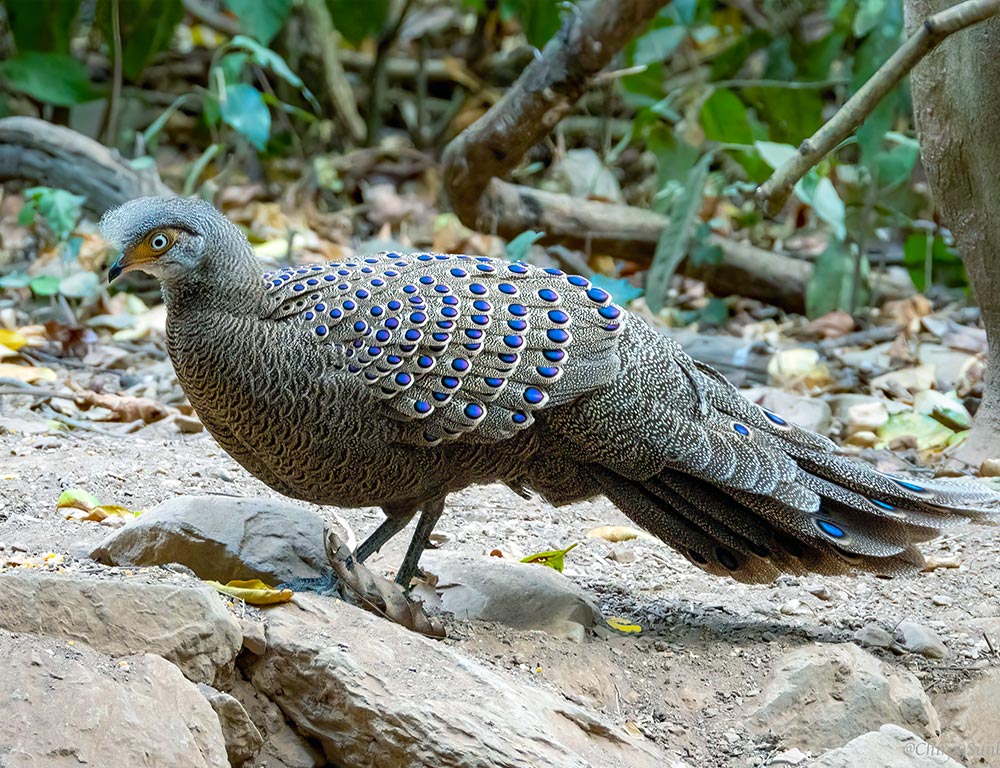
The gray peacock-pheasant, also known as the Burmese peacock-pheasant, is a large and impressive bird native to Asia. It is a member of the order Galliformes, which is the same order that chickens, turkeys, pheasants, and grouse belong to.
This bird has a long, thin neck and a long, rounded tail, and is covered in gray feathers with a distinctive iridescent blue sheen. Its head is adorned with a long crest of feathers and a patch of bare, blue skin on its face.
The bird can grow up to two feet tall and has a wingspan of up to three feet. Its habitat includes the humid forests of Myanmar, Thailand, and Laos, and it feeds mainly on fruits and insects. It is a solitary bird and is generally found perched in trees or on the ground.
It is typically shy and secretive and is most active during the early morning and evening hours. Despite its size and beauty, the gray peacock-pheasant is rather elusive and is rarely seen in the wild.
It is listed as endangered by the International Union for Conservation of Nature (IUCN), with its main threats being deforestation and hunting.
| Kingdom | Animalia |
| Phylum | Chordata |
| Class | Aves |
| Order | Galliformes |
| Family | Phasianidae |
| Genus | Polyplectron |
| Species | P. bicalcaratum |
33. Golden-throated Barbet
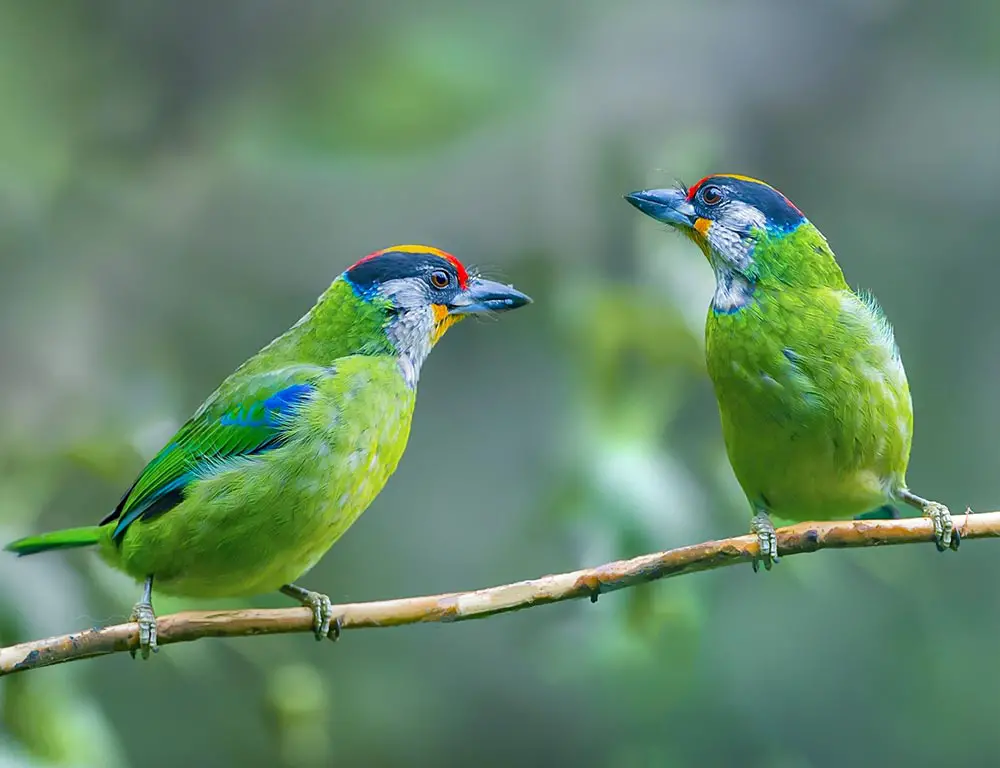
The golden-throated barbet is a small bird species native to Southeast Asia. It is recognized for its unique yellow throat feathers, which distinguish it from other species of Asian barbet. The barbet typically resides in forests between 900 and 2,700 meters in altitude.
The bird is a generally widespread species, and its population has remained relatively stable over recent years, leading the International Union for Conservation of Nature (IUCN) to list it as a species of Least Concern.
The IUCN Red List is a compilation of species and their associated conservation statuses. Species listed as Least Concern are those that are abundant and not currently threatened and do not require immediate conservation action.
This is the case for the golden-throated barbet, which has a wide distribution throughout Southeast Asia and a stable population. As such, it is a species in relatively good standing from a conservation perspective.
| Kingdom | Animalia |
| Phylum | Chordata |
| Class | Aves |
| Order | Piciformes |
| Family | Megalaimidae |
| Genus | Psilopogon |
| Species | P. franklinii |
34. Green Cochoa
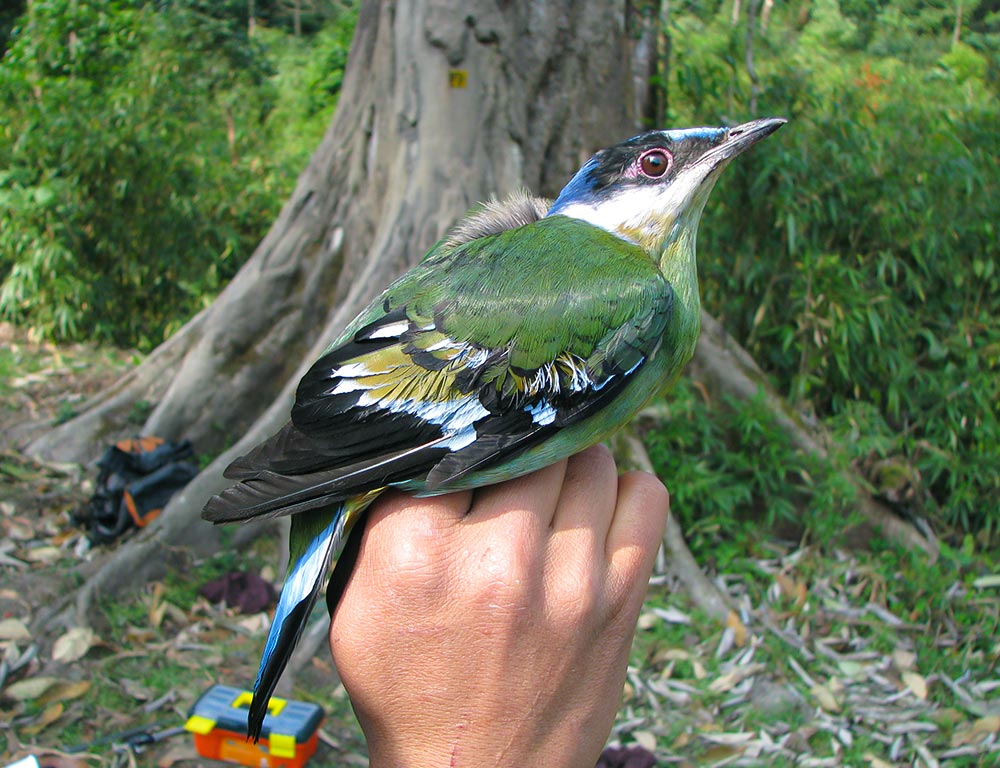
The green cochoa is an uncommon bird species with a limited range across the Himalayas and parts of Asia. It was traditionally placed in the thrush family Turdidae, however, recent studies have determined that it is closer related to the Muscicapidae family.
This makes it the only member of the Muscicapidae family that is not a flycatcher. Its behavior and vocalizations also indicate that the green cochoa is more closely related to the thrush family.
The green cochoa is an important species as its presence within a habitat is a sign of a healthy ecosystem. It is also a valuable species for evolutionary and taxonomic studies.
| Kingdom | Animalia |
| Phylum | Chordata |
| Class | Aves |
| Order | Passeriformes |
| Family | Turdidae |
| Genus | Cochoa |
| Species | C. viridis |
35. Common Green Magpie
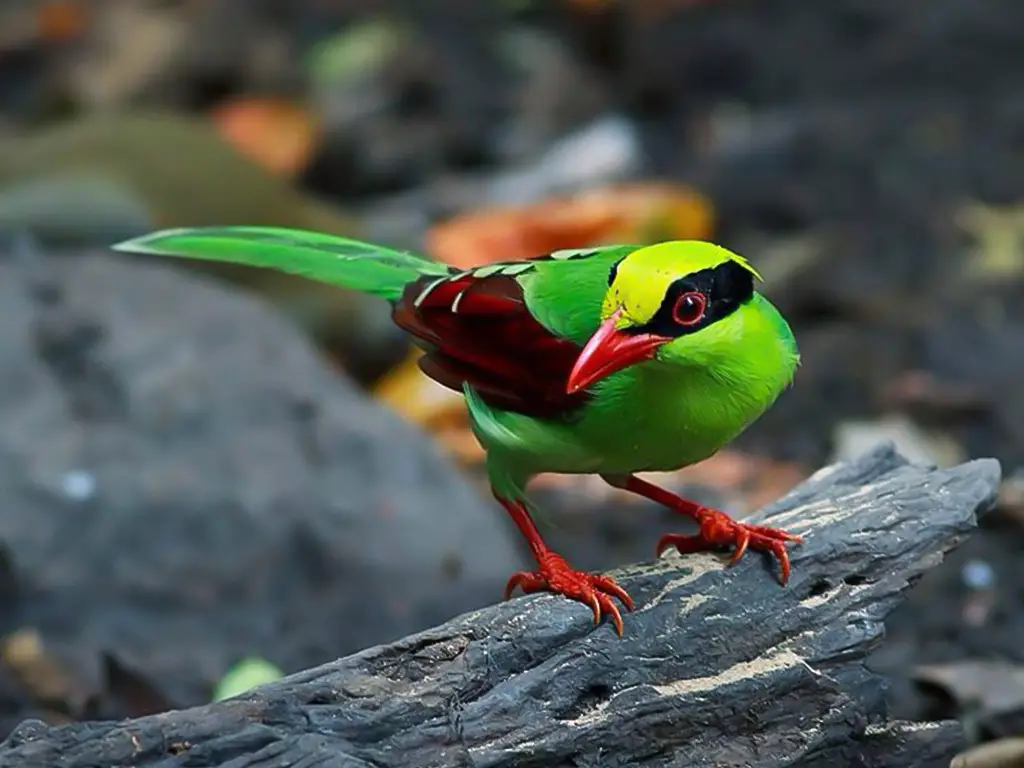
The common green magpie is an impressive bird that belongs to the crow family. It is roughly the size of the Eurasian jay or slightly smaller.
Its striking appearance is characterized by its bright green feathers, which are slightly more light in color on the underside.
Additionally, it has a thick black stripe that runs from its bill to the back of its neck. This distinctive marking sets it apart from other species in the crow family. In the wild, the common green magpie can be seen in its bright green hue.
Its feathers are glossy in appearance, and its beak is a bright yellow. It is quite an active bird, often seen hopping around in trees or on the ground. It also has an impressive vocal range and is known to make a variety of different calls.
The common green magpie is a fascinating species of bird and has been the subject of many studies and research. It is found in several countries in Asia, and its population is believed to be on the rise.
It is a species of least concern, and conservation efforts are being made to protect it. Overall, the common green magpie is a remarkable species of bird. Its bright green color and distinctive black stripe make it a striking sight to see in the wild.
It is an active species with an impressive vocal range and is believed to be on the rise in some parts of Asia. Conservation efforts are being made to ensure that this species remains protected.
| Kingdom | Animalia |
| Phylum | Chordata |
| Class | Aves |
| Order | Passeriformes |
| Family | Corvidae |
| Genus | Cissa |
| Species | C. chinensis |
36. Himalayan Cutia
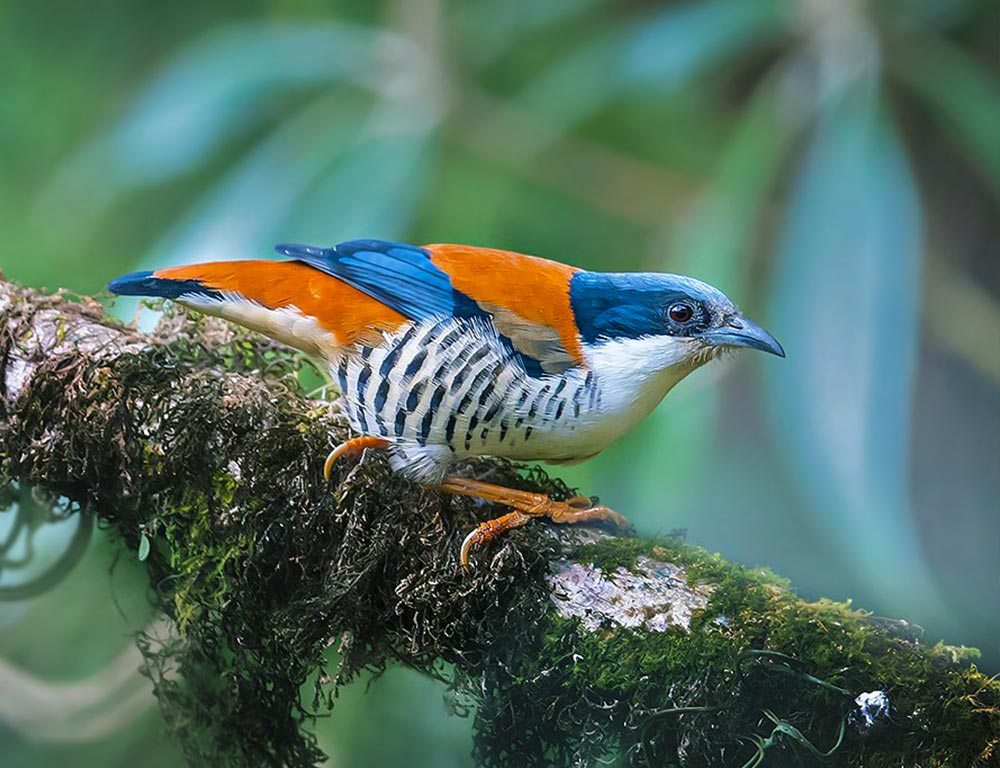
The Himalayan cutia is a species of bird that belongs to the family Leiothrichidae. Its scientific name, Cutia nipalensis, is derived from the Nepali name for these birds. This species is found in the Himalayan region, which stretches from India to northern Thailand.
The scientific name implies that the bird originates from Nepal, which is why the name ‘nipalensis’ is used. The Himalayan cutia is a small bird, with a black head and white throat. It has a distinctive call, which is said to sound like a ‘tuk-tuk-tuk’.
They are often seen in small groups, as they prefer to live in open woodlands, scrublands, and gardens. They eat mainly insects and berries. The Himalayan cutia is an important species in the region, as it helps to control insect populations, and provides food for other animals.
Unfortunately, their numbers are declining due to habitat loss and trapping. Conservation efforts are underway to protect this species and its habitat.
| Kingdom | Animalia |
| Phylum | Chordata |
| Class | Aves |
| Order | Passeriformes |
| Family | Leiothrichidae |
| Genus | Cutia |
| Species | C. nipalensis |
37. Asian Barred Owlet
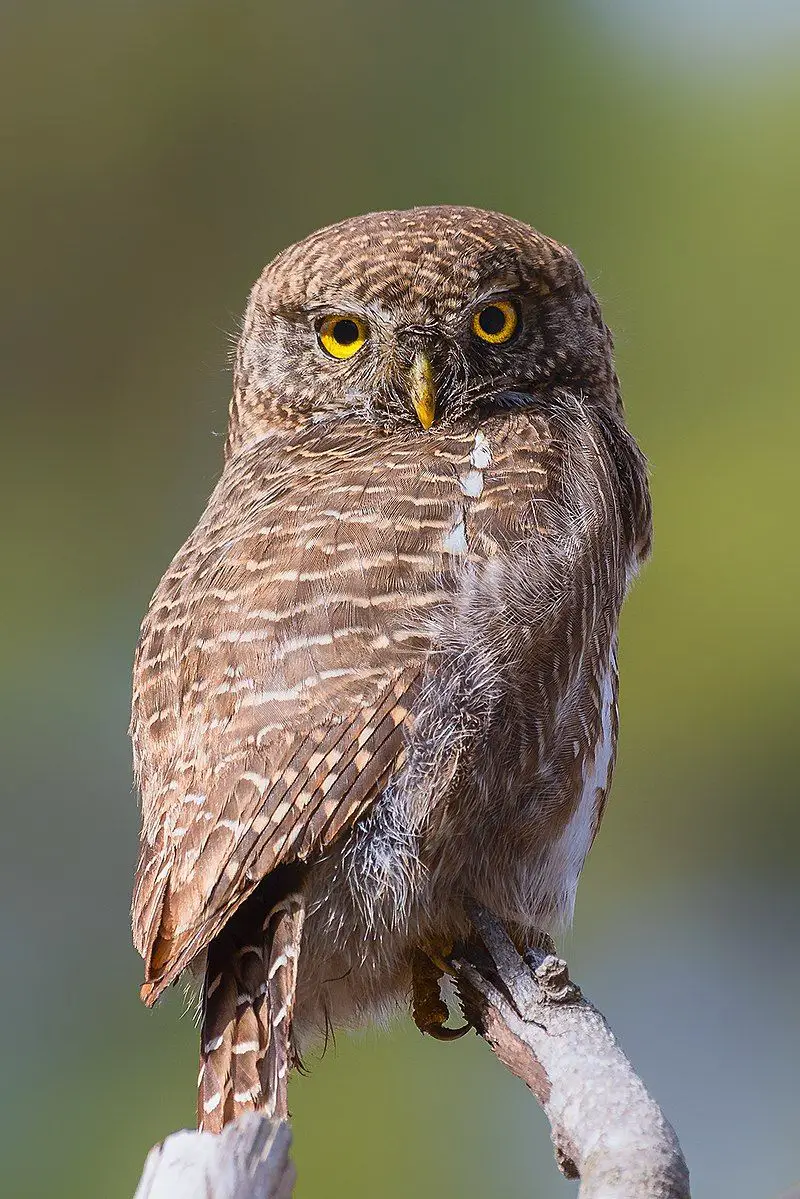
The Asian barred owlet is a species of small owl that inhabits temperate forests in parts of southern China, the Indian Subcontinent, and mainland Southeast Asia.
It is a very small species, measuring about seven inches in length, with striking black-and-white coloration and yellow eyes. Its habitat is characterized by dense stands of trees with an understory of shrubs and grasses, which provides plenty of cover.
The owlets feed on a variety of small birds, insects, and rodents, and are active mainly during the day. They typically nest in cavities of dead trees or in abandoned nests of other birds.
Breeding occurs throughout the year, with the female laying two to four eggs in a single clutch. The chicks fledge in about four weeks, and the adults provide food for them until they can hunt for themselves.
The Asian barred owlet is listed as the Least Concern on the IUCN Red List.
| Kingdom | Animalia |
| Phylum | Chordata |
| Class | Aves |
| Order | Strigiformes |
| Family | Strigidae |
| Genus | Glaucidium |
| Species | G. cuculoides |
38. Taiga Flycatcher
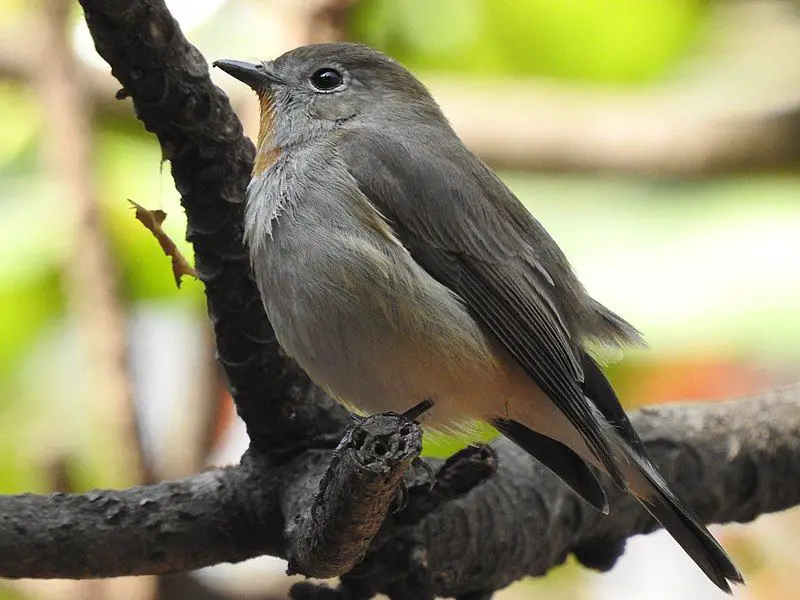
The taiga flycatcher, also known as the red-throated flycatcher, is a small migratory bird found in the family Muscicapidae. First described by Peter Simon Pallas in 1811, the taiga flycatcher is known for its distinct and unique appearance.
The female of the species has brown upper parts, with a blackish tail that is flanked by white. The breast is buffish, and the underparts are mostly white.
The taiga flycatcher is a unique species of bird, and it can be easily identified by its unique coloration and pattern. The taiga flycatcher is a migratory bird, meaning that it will travel long distances in search of a suitable habitat in which to raise its young.
It is an important part of the natural cycle, as it helps to control insect populations and disperse seeds.
| Kingdom | Animalia |
| Phylum | Chordata |
| Class | Aves |
| Order | Passeriformes |
| Family | Muscicapidae |
| Genus | Ficedula |
| Species | F. albicilla |
39. Fire-tailed Sunbird
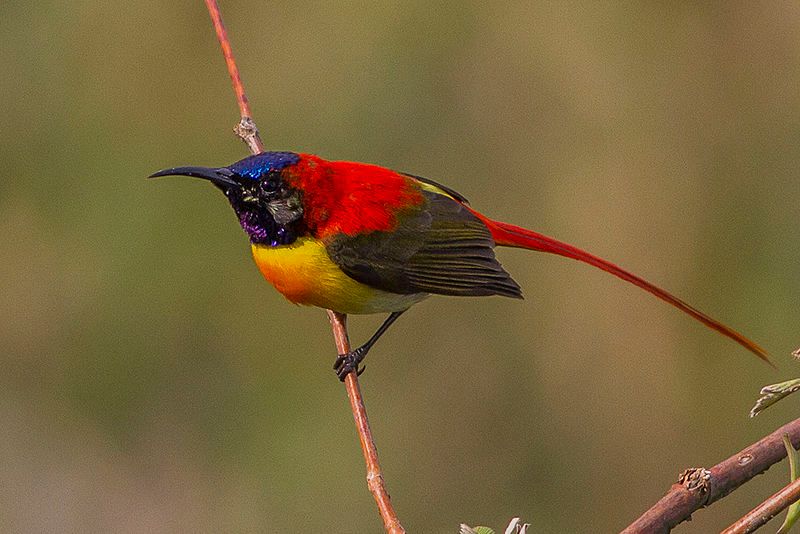
The fire-tailed sunbird is a species of sunbird found in the northern parts of the Indian subcontinent, primarily in the Himalayas, and also in some adjoining regions in Southeast Asia. It is a member of the family Nectariniidae, which includes several sunbird species.
This species can be found in Bangladesh, Bhutan, India, Myanmar, Nepal, Thailand, and Tibet. The fire-tailed sunbird is a colorful bird with a distinctive red tail.
It has a light gray body with white underparts and a black line extending from the forehead to the nape of the neck. The fire-tailed sunbird feeds on nectar, insects, and other small invertebrates. It is an active and vocal bird, often seen flitting among trees and shrubs.
It nests in trees, often near water bodies, and is known to breed throughout the year. The fire-tailed sunbird is a species of conservation concern due to its limited range and declining population.
Its vulnerability is further increased by habitat loss due to land conversion for agriculture and the spread of invasive species.
To help protect this species, conservation measures should be implemented, such as habitat protection and restoration, controlling invasive species, and monitoring of its population.
| Kingdom | Animalia |
| Phylum | Chordata |
| Class | Aves |
| Order | Passeriformes |
| Family | Nectariniidae |
| Genus | Aethopyga |
| Species | A. ignicauda |
40. Purple Cochoa
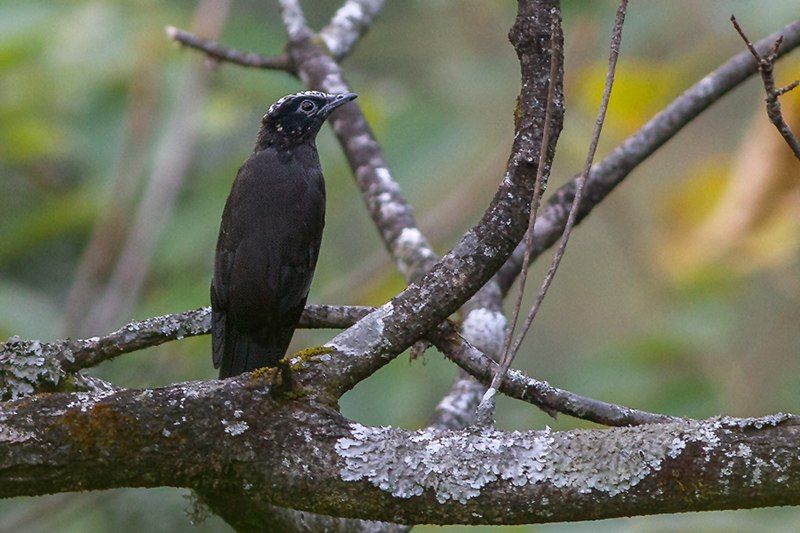
The purple cochoa is a beautiful avian species found in the temperate forests of Asia. It is a shy and reclusive bird and stands out with its vibrant coloring. It is thought to be closely related to the thrushes of the Turdidae family or the Muscicapidae family.
This relation is based on its physical characteristics and behavior, such as its beak shape and song. The purple cochoa is an omnivore, meaning it eats a variety of food. It feeds on insects, fruits, and berries.
It also has a unique vocalization, which is a low and fluty chirping sound. It is an active bird, often seen foraging for food or searching for nesting sites. The purple cochoa is a solitary bird and is usually found alone or with a single mate.
It is believed that these birds mate for life and may even defend their territories aggressively. They are known to make their nests in cavities in trees, in dense foliage, or on the ground.
The purple cochoa is a threatened species, due to the destruction of its habitat caused by deforestation and agricultural activities. Efforts are being made to protect and conserve this species, as it plays an important role in the ecosystem of the temperate forests of Asia.
| Kingdom | Animalia |
| Phylum | Chordata |
| Class | Aves |
| Order | Passeriformes |
| Family | Turdidae |
| Genus | Cochoa |
| Species | C. purpurea |
41. Oriental Scops Owl
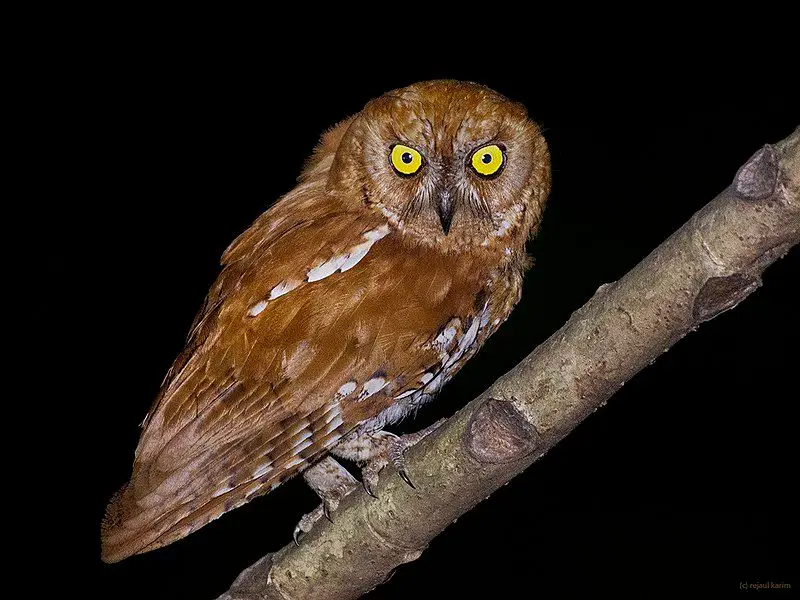
The Oriental Scops Owl is a species of owl typically found in the eastern and southern regions of Asia. It is a relatively small owl, measuring in at around 7.5 to 9 inches in length. Its plumage is predominantly grey-brown, with darker brown and light brown streaks and spots.
Its facial disc is whitish with a pale yellow hue, and it has yellow irises. Its wings are long and slender, with a wingspan reaching up to 16 inches. The Oriental Scops Owl is mostly nocturnal and is normally found in wooded areas or near human settlements.
It feeds on a variety of small animals, including insects, lizards, and mice. It typically nests in tree cavities or holes and will use abandoned nests of other birds if available.
It is known for its distinctive call, which is described as a loud “hoot”.The Oriental Scops Owl is listed as “Least Concern” by the International Union for Conservation of Nature (IUCN).
Although its population is thought to be decreasing due to the destruction of its habitat, it is still relatively common and found in large parts of its range.
| Kingdom | Animalia |
| Phylum | Chordata |
| Class | Aves |
| Order | Strigiformes |
| Family | Strigidae |
| Genus | Otus |
| Species | O. sunia |
42. Lesser Shortwing

The lesser shortwing is a species of chat belonging to the family Muscicapidae. It is a small bird found in Southeast Asia, Sumatra, Java, and the Lesser Sundas, and inhabits subtropical or tropical moist montane forests.
These forests are characterized by high levels of humidity and rainfall and are usually located in mountainous regions. The lesser shortwing is a unique species, as it is the only one in its family to inhabit such a specific habitat.
It typically lives in small flocks and feeds on insects, seeds, and fruits. Its population is decreasing due to deforestation, and it is therefore classified as a vulnerable species by the International Union for Conservation of Nature (IUCN).
Conservation efforts are necessary to ensure the survival of this species and its habitat.
| Kingdom | Animalia |
| Phylum | Chordata |
| Class | Aves |
| Order | Passeriformes |
| Family | Muscicapidae |
| Genus | Brachypteryx |
| Species | B. leucophris |
43. Blue-eared Kingfisher
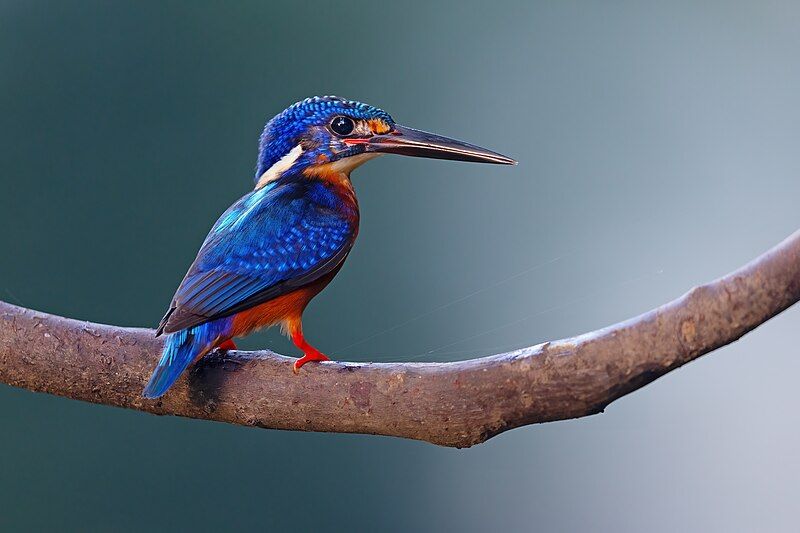
The blue-eared kingfisher is a species of bird native to Asia. Its range covers the Indian subcontinent and Southeast Asia. It prefers to inhabit dense, shaded forests, where it can hunt for fish in the small streams that are found within these areas.
It is a relatively small bird, with a slender bill and bright blue ear patches. It feeds mainly on fish, but also insects, crustaceans, and other small aquatic creatures. The blue-eared kingfisher is a solitary bird and is rarely seen in groups.
It is quite active during the day and is often seen perched on branches overhanging streams, looking for its prey. When it spots a potential meal, it dives into the water and catches it in its bill.
Its bright colors make it easy to spot in the dense forest. The blue-eared kingfisher is a unique species and plays an important role in the local ecosystem. It helps maintain healthy fish populations, which in turn provides food for other animals in the area.
It is also a popular bird for birdwatchers, as its colorful plumage makes it easy to spot. Overall, the blue-eared kingfisher is a beautiful and important species, and its presence in our forests is a sign of a healthy ecosystem.
| Kingdom | Animalia |
| Phylum | Chordata |
| Class | Aves |
| Order | Coraciiformes |
| Family | Alcedinidae |
| Genus | Alcedo |
| Species | A. meninting |
44. Green Imperial Pigeon
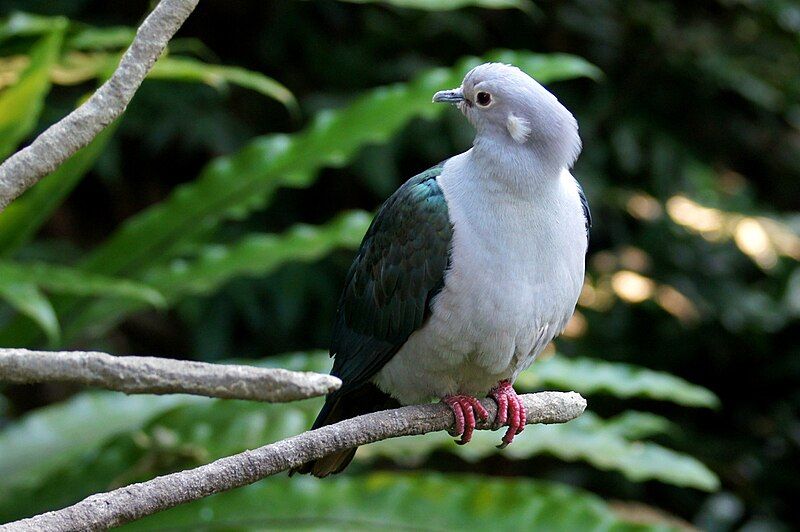
The green imperial pigeon is a species of bird that is found in the forests of some parts of Asia. It is a large bird with a wingspan of up to 50 inches, making it one of the largest pigeons in the world.
Its range extends from Nepal in the west, to southern India and Sri Lanka, and eastwards to southern China, Indonesia, and the Philippines. It is a mainly green bird with a blue-grey head and is found in dense forests where it feeds on fruits, nuts, and seeds.
The female lays a single egg in a flimsy platform nest, which is usually built high up in a tree. This species is threatened by habitat destruction and hunting and is listed as Vulnerable on the IUCN Red List.
| Kingdom | Animalia |
| Phylum | Chordata |
| Class | Aves |
| Order | Columbiformes |
| Family | Columbidae |
| Genus | Ducula |
| Species | D. aenea |
45. Streak-throated Barwing
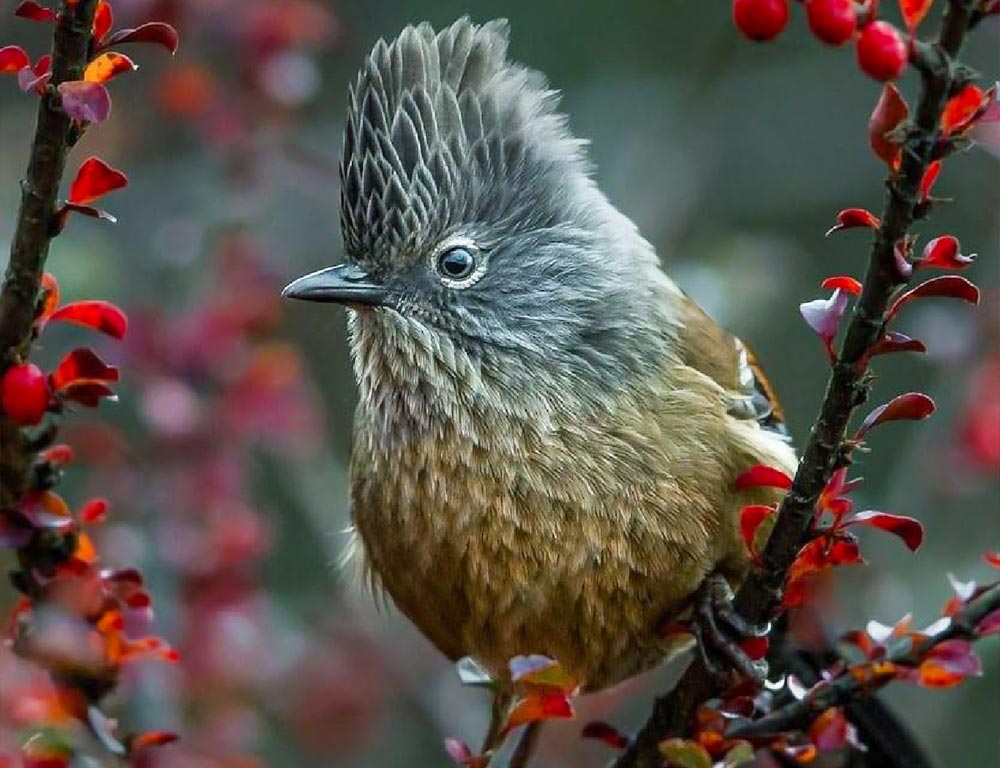
The streak-throated barwing is an interesting species of bird that belongs to the family Leiothrichidae. This species is native to four different countries, including western Yunnan, southern Tibet, Northeast India, and Myanmar.
Its natural habitat is in the moist montane forests found in these countries, which are subtropical or tropical. These birds are quite small in size and can be identified by their distinct coloration.
The upper parts of the bird are usually a shade of grey, while the lower parts are usually a white or yellowish color.
The throat of the bird is where its name comes from, as it is usually streaked or barred with a shade of brown or black. The streak-throated brewing is an omnivore and feeds on a variety of items found in its natural habitat.
This includes small insects, fruits, and other small items. This species is known to be quite shy and reclusive and is rarely seen in the wild. Overall, the streak-throated barwing is an interesting species of bird that is found in four different countries.
It is a small bird with a unique coloration and is often found in moist montane forests. This species is an omnivore that feeds on a variety of items found in its natural habitat and is usually quite shy and reclusive.
| Kingdom | Animalia |
| Phylum | Chordata |
| Class | Aves |
| Order | Passeriformes |
| Family | Leiothrichidae |
| Genus | Actinodura |
| Species | A. waldeni |
46. Blue-naped Pitta
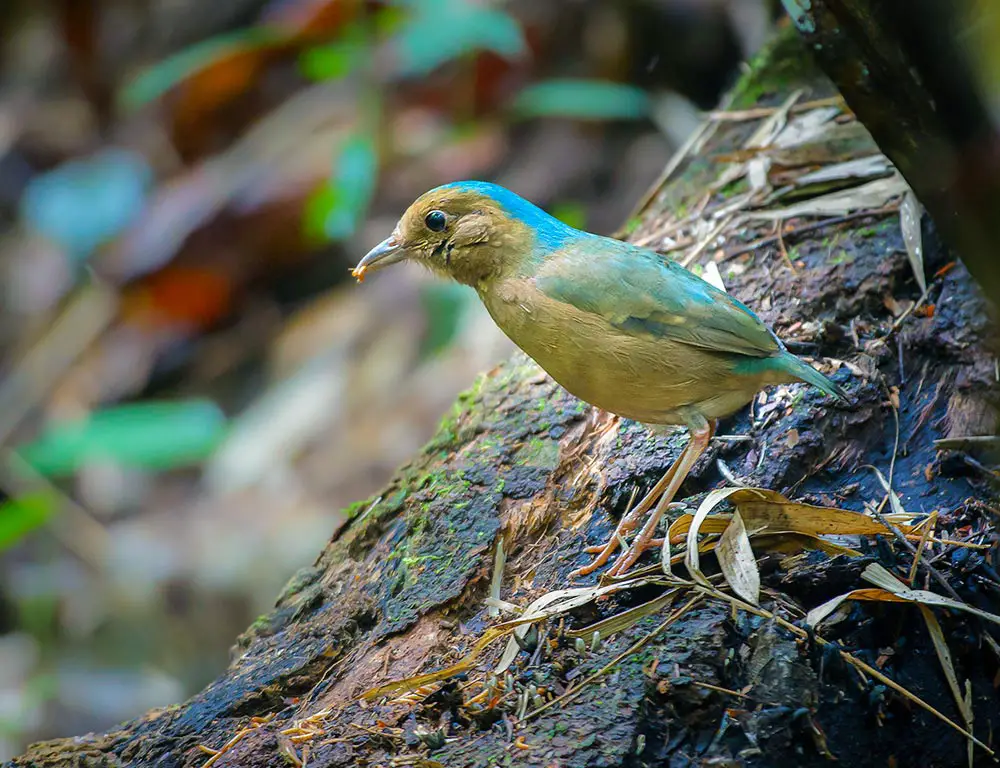
The blue-naped pitta is a species of bird belonging to the family Pittidae. Pittas are colorful, medium-sized birds that are found mainly in tropical and subtropical regions of the world.
They are usually found in dense forests and woodlands, and some species live in mangroves and rainforests. The blue-naped pitta is a brightly colored bird with a yellowish-green back, a white throat, and a blue-black head and breast.
It also has a distinctive white line that runs along its upper back. These birds are omnivorous, meaning they feed on both plants and animals. They feed on insects, small frogs, snails, and fruits. They are also known to forage on the ground for food.
They are found mainly in Indonesia and the Philippines and live in lowland forests and woodlands. The blue-naped pitta is considered to be a vulnerable species due to its decreasing population. Conservation efforts are underway to help protect this species of bird.
| Kingdom | Animalia |
| Phylum | Chordata |
| Class | Aves |
| Order | Passeriformes |
| Family | Pittidae |
| Genus | Hydrornis |
| Species | H. nipalensis |
47. Jerdon’s Baza

Jerdon’s baza is a species of brown hawk native to Southeast Asia. It has a distinctive appearance, with a thin white-tipped black crest that is usually held erect. This hawk is found in the foothills of the Terai and is rarer in evergreen forests and tea estates.
The common name and Latin binomial of this species commemorates the surgeon-naturalist Thomas C. Jerdon. Thomas C. Jerdon was an English surgeon and naturalist who lived in the 19th century. He was known for his work in India, where he studied birds and other animals.
He wrote several books on the topic, including The Birds of India. Jerdon was also renowned for his work in identifying and describing new species of birds. In recognition of his contributions to natural history, Jerdon’s baza was named after him.
This species is a fitting tribute to his memory as it is a unique hawk found only in Southeast Asia. It is a moderate-sized bird with a striking appearance, and its white-tipped black crest is a distinctive feature.
It inhabits foothills and is rarer in evergreen forests and tea estates. Overall, Jerdon’s baza is a unique species of hawk that serves as a reminder of Thomas C. Jerdon’s legacy.
His scientific work in India was invaluable, and it is fitting that a species of hawk bears his name. This hawk is found only in Southeast Asia and is a rare sight in its native habitat.
| Kingdom | Animalia |
| Phylum | Chordata |
| Class | Aves |
| Order | Accipitriformes |
| Family | Accipitridae |
| Genus | Aviceda |
| Species | A. jerdoni |
Conclusion
Northeast India is a unique and diverse area that supports a wide variety of birds. Many of the bird species are endemic to the region, and some are threatened or endangered.
The region’s forests, wetlands, grasslands, and rivers provide a rich diversity of habitats that support a variety of bird species.
Conservation efforts, such as habitat protection, are needed to protect and preserve these species for future generations.